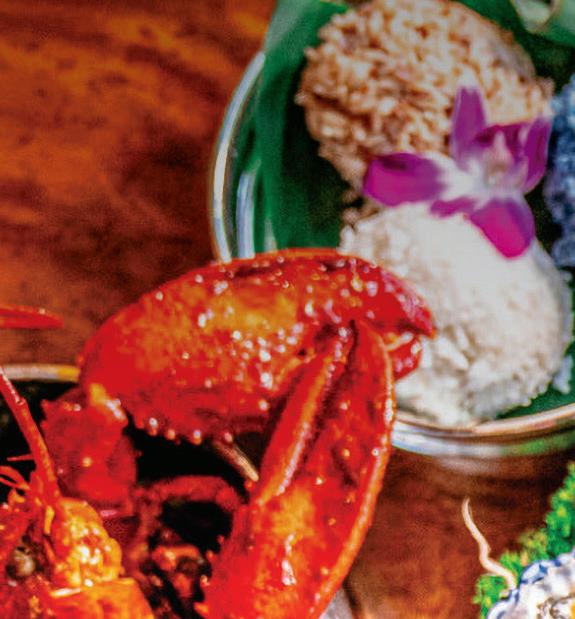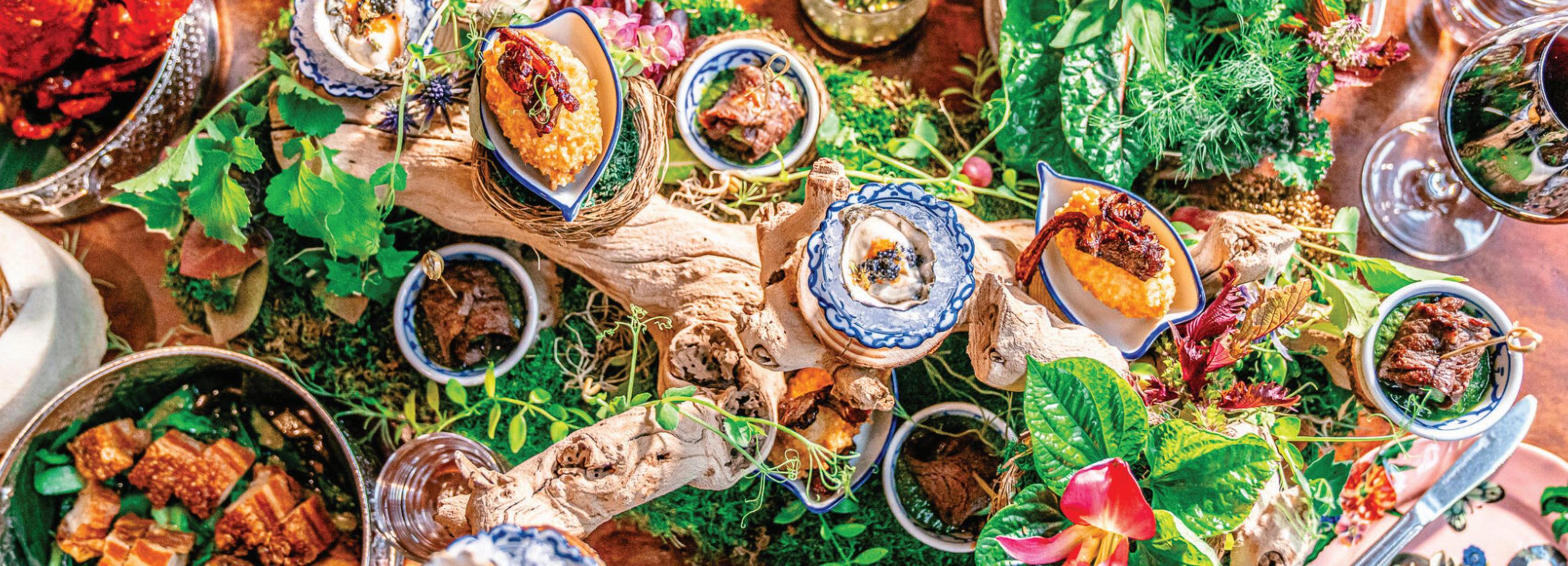






















GIANLUCA GUGLIELMI CARES AND CURES AT DONATO & CO






















GIANLUCA GUGLIELMI CARES AND CURES AT DONATO & CO


























GIANLUCA GUGLIELMI CARES AND CURES AT DONATO & CO






















GIANLUCA GUGLIELMI CARES AND CURES AT DONATO & CO








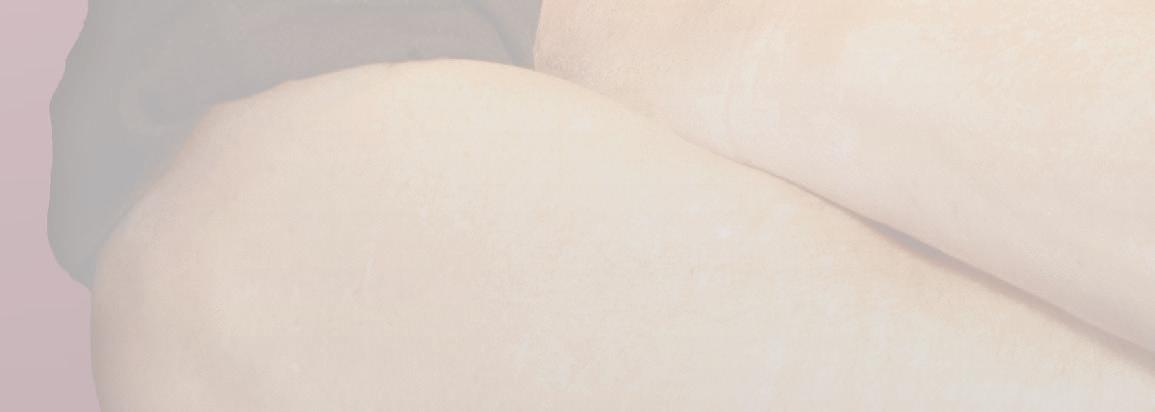



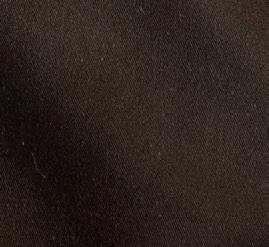







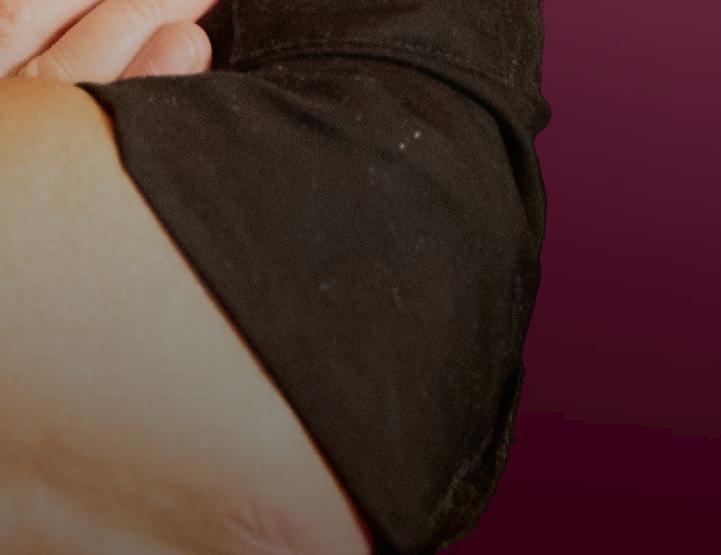








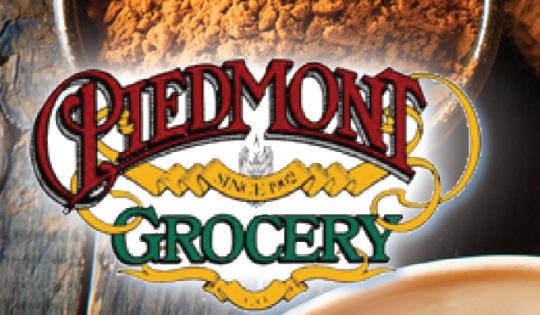


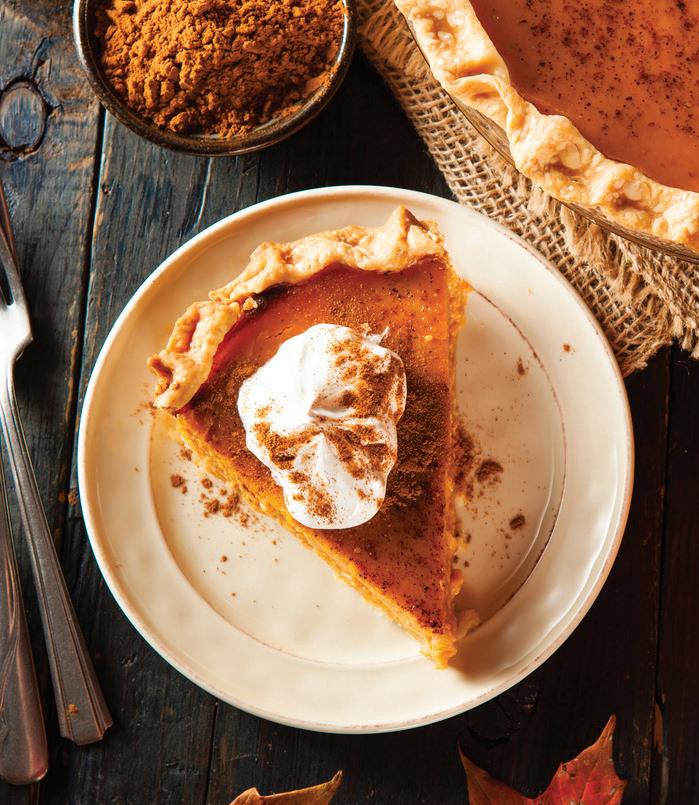
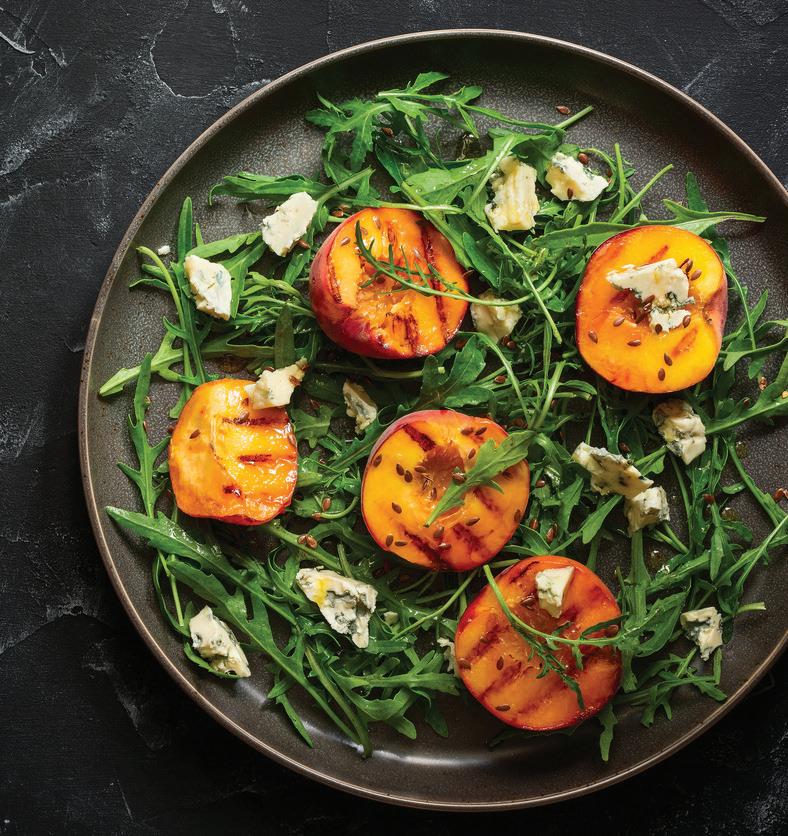




Iwent through a “mod” phase in my early teens. On weekend visits, my kind and patient grandmother would take me to the nearest thrift stores, helping to find ’60s shift dresses, gloves and pillbox hats (and likely having a good chuckle about my retro style). She was less thrilled about a few of my subsequent fashions—frankly, me too! Yet another reason to be glad there was no social media back then.
Style is personal. And for most folks, it evolves throughout our lives just as we do. Major events and life transitions generally boost that change. Hence, the confusion of what to wear post-pandemic when many of us now work from home. Although I suppose yoga pants and old T-shirts are its own kind of style. Who am I to judge?
Thankfully, Oakland designer Lesley Evers brings a sense of nostalgia and joy into her stylistic expressions. Geometric
JEFFREY EDALATPOUR writes about arts, food and culture for SF Weekly, Metro Silicon Valley, East Bay Express and KQED Arts.
LOU FANCHER has been published in Diablo Magazine, Oakland Tribune, InDance, San Francisco Classical Voice, SF Weekly, WIRED.com and elsewhere.
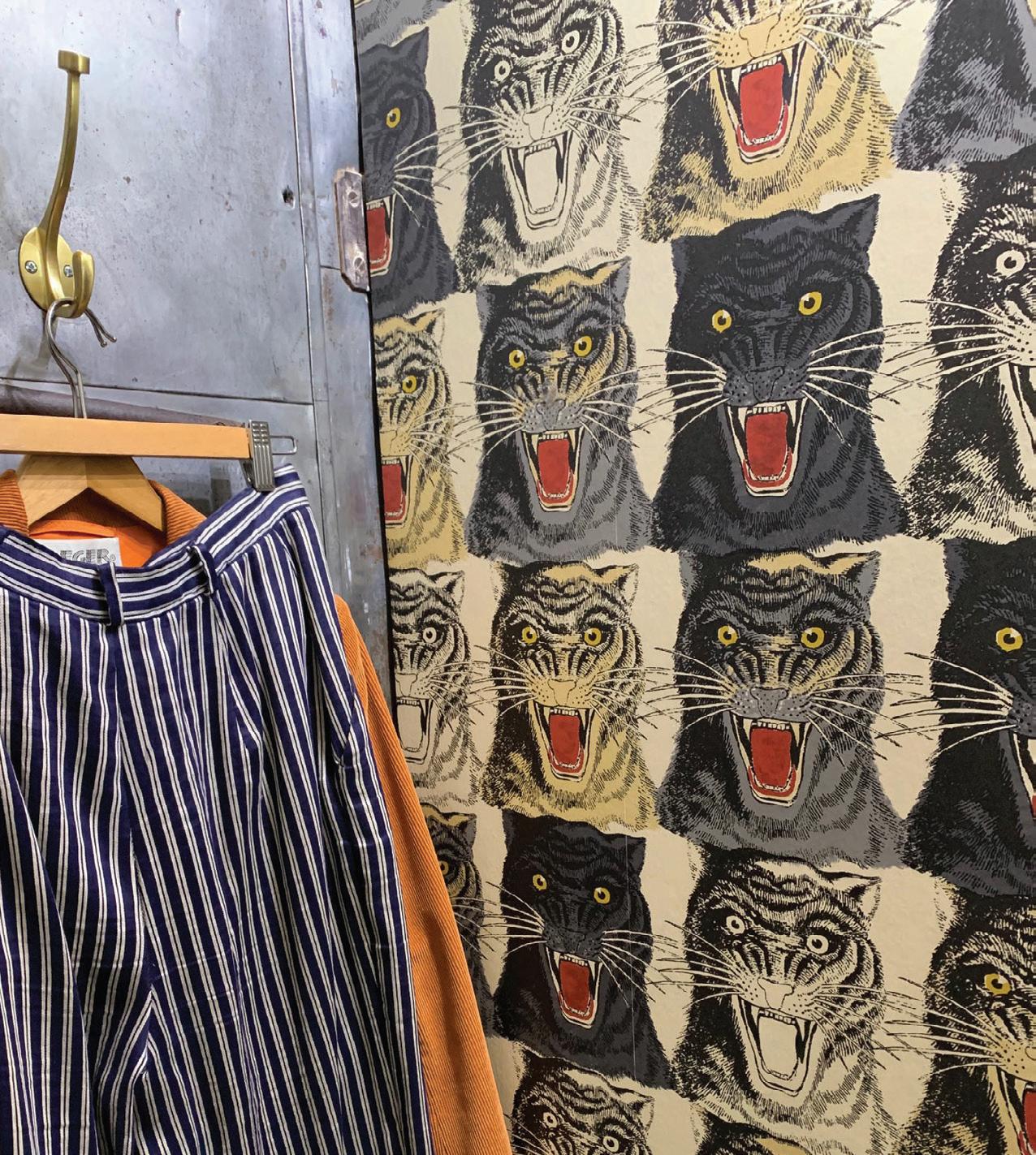
shapes, bright colors and a touch of whimsy enhance her flattering women’s wear pieces. In this issue, we learn more about her fall-focused innovations and retail store updates.
We also talked with a few local “stylistas” about what style means to them. From a 17 year old who designed an awardwinning dress made from BART tickets, to a beloved costume-designing drama teacher at the Bentley School, to a former Beverly Hills Banana Republic merchandiser turned jewelry designer in Kensington and to a popular vintage shop owner in Elmwood, their confidence and creativity inspire us.
In a sense, vintage fashion never goes out of style. That’s why we also highlighted a few more local vintage shop owners. They’ve seen it all! Their origin stories are relatable, and their shared quest to preserve the sustainability of used clothing is much admired and in
JANIS HASHE regularly contributes to the East Bay Express and other Bay Area publications.
BILL KOPP writes about music for Spin, Grammy.com, Record Collector, Goldmine and alt weeklies in the Bay Area and across the U.S.
demand. In fact, the U.S. secondhand apparel market is expected to reach $73 billion by 2028.
Of course, style is not just about fashion. Oakland guitarist Jubu Smith is a collaborative legend in the jazz world. But when it comes to promoting his solo debut album, the media-shy artist’s style is decidedly “let the music speak for itself.”
Illustrator Jane Kim’s lush art depicts a reverence for nature, and an inclination to dive deep into the stories behind the Bay Area’s diverse flora and fauna. For Kim, the joy of falling into figurative rabbit holes is a key component of her style.
For its delectable dedication to elevated vegan cuisine, we also celebrate the 30th anniversary of Millennium in Rockridge. And we sat down to eat in Italian style at Berkeley’s Donato & Co., courtesy of the hospitality and passion of chef Gianluca Guglielmi, this issue’s cover star.
— Samantha Campos
BROOKE MOHIUDDIN is a writer and photographer for portraits, events and concerts in the Bay Area. She is currently a high school junior.
LISA PLACHY is a San Francisco-based writer who covers arts, community and culture in the Bay Area.



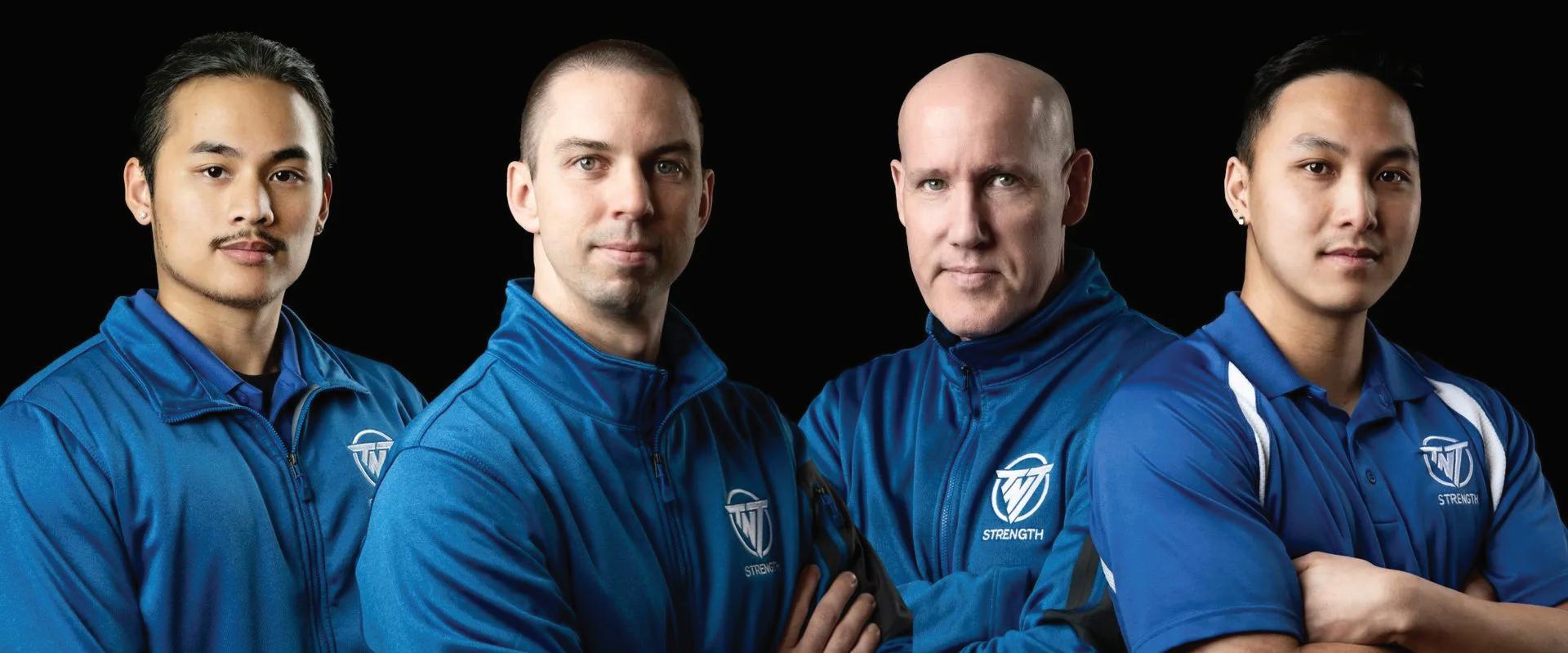
MOOD BOOSTER Lesley Evers sticks to bright colors, even in the fall, saying, ‘Colors can lift people’s spirits.’





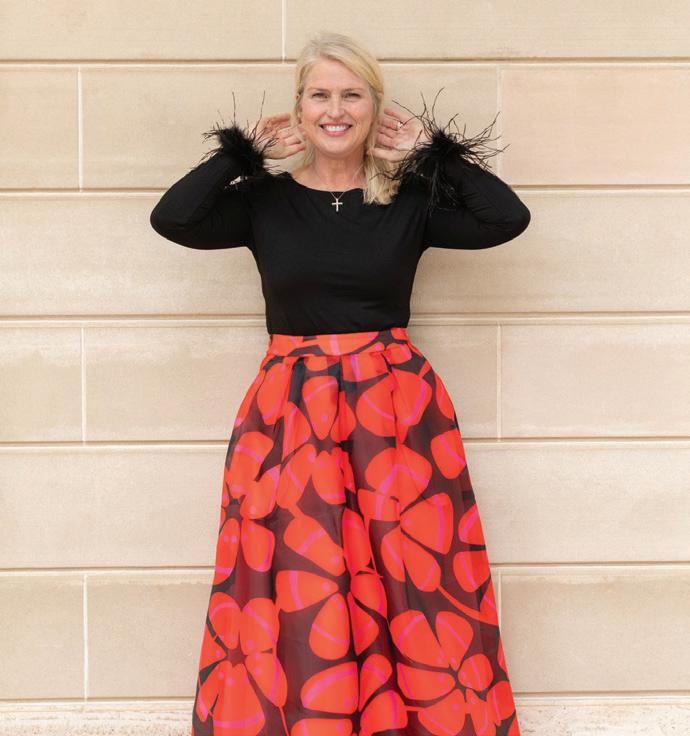
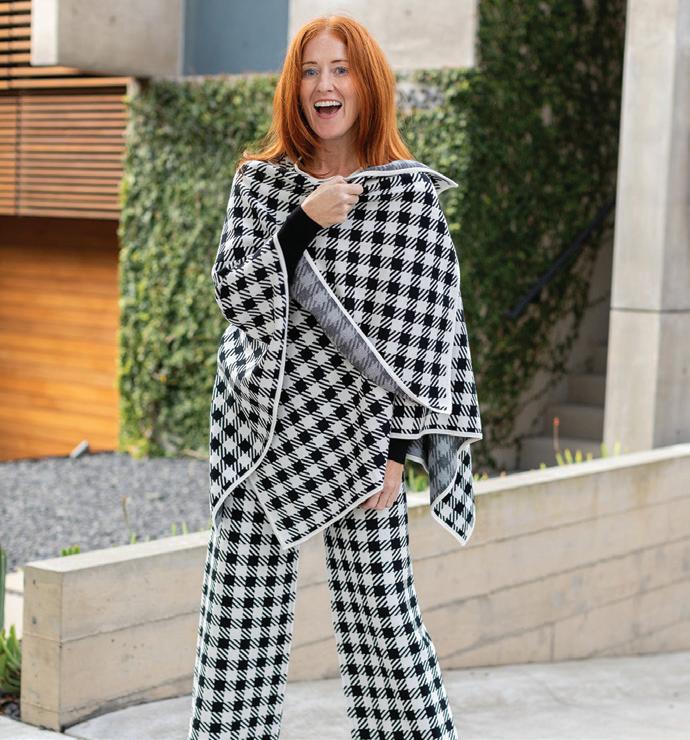
BY Lou Fancher
Colors can lift people’s spirits,” says designer Lesley Evers. “I have a customer who said she started wearing our clothes and it changed her mindset. She ate better, started moving more and felt better about herself. I was so touched.”
Since 2008, Evers has gradually created a line of womenswear that embodies the sophisticated, exuberant, and practical needs and desires of her customers. Launching the company that bears her name with dresses and eventually selling at over 100 boutiques nationwide, Evers
in 2012 opened a bricks-and-mortar shop in Oakland.
When in-person and online orders boomed, the company’s all-local manufacturing ethos had to expand overseas to scale up and meet demand. Even so, Evers remains committed to local sourcing of materials and services whenever possible.
The line has grown well beyond dresses (all bearing women’s names like Molly, Phoebe, Cara, Nadia and more) and includes new clothing and accessory items, plus homeware and gifts. Throughout,
Oakland’s womenswear designer Lesley Evers combines know-how, nostalgia and a sense of fun
the original design vision remains the same. Emphasis in all categories leans to comfort, practicality and a delightful sense of liberated fun most often expressed with bold floral or graphic prints and pops of bright color that carry names such as those on a “Chicka Boom Orange” jacket, a “Dandelion” cardigan and other items.
Among the more sedate items are solid indigo denim pieces and two-tone dresses such as the “Drew” in a navy and white fern-patterned fabric and the A-line “Harriet” option that comes in navy scoops, but also o ers livelier
« echinacea and blossom breeze pink.
Personable, customer-friendly service and dedication to employees could be considered givens for any successful small business, but are core practices Evers spends considerable time and effort maintaining. During Covid, she had to close the in-person shop and let people go. She pulled back, shifted to making masks and used the time to rejuvenate herself, design new items and refine the company’s delivery channels and manufacturing processes.
It’s fortunate she did, because from 2021 to 2022, Evers’ online business tripled, and then it doubled in 2023. In 2024, while the e-commerce business continues to thrive, there are three bricksand-mortar shops: the flagship store in Oakland’s Rockridge district, and smaller shops in Palo Alto as well as in Portland, OR. Most recently, Evers has re-built the company’s wholesale website and has 10 stores carrying products and another 20 shops awaiting delivery of their orders.
“We have a channel where stores can apply,” says Evers. “To select who we choose, we basically look them up to see if they have good customer service, because that matters most to us.”
In a conversation focusing on new items introduced or expanded for the fall and holiday season, Evers says, “We’re sticking to bright colors, even in the fall. I go into deep burgundy, green, navy—with pops of pink.” She releases new products weekly, and a bird-themed shirt is already being knocked off by a company in China. It’s an odd, unpleasant badge of honor Evers says cannot be avoided.
“You can’t stop it,” Evers says. “I saw it because it popped up on my Instagram. You spend so much time making original things, but once it’s on the internet, people will copy it. As an artist, I have to let that go and just continue to make beautiful things, things that fit well and are practical and versatile.”
Practicality and versatility come together in dresses, tops and skirts; almost all with ever-important pockets perfect for carrying today’s pervasive cell phones. Dress length and fabric patterns vary so a dress worn to the office during the day can easily transition into evening wear with the addition of accessories like handbags,
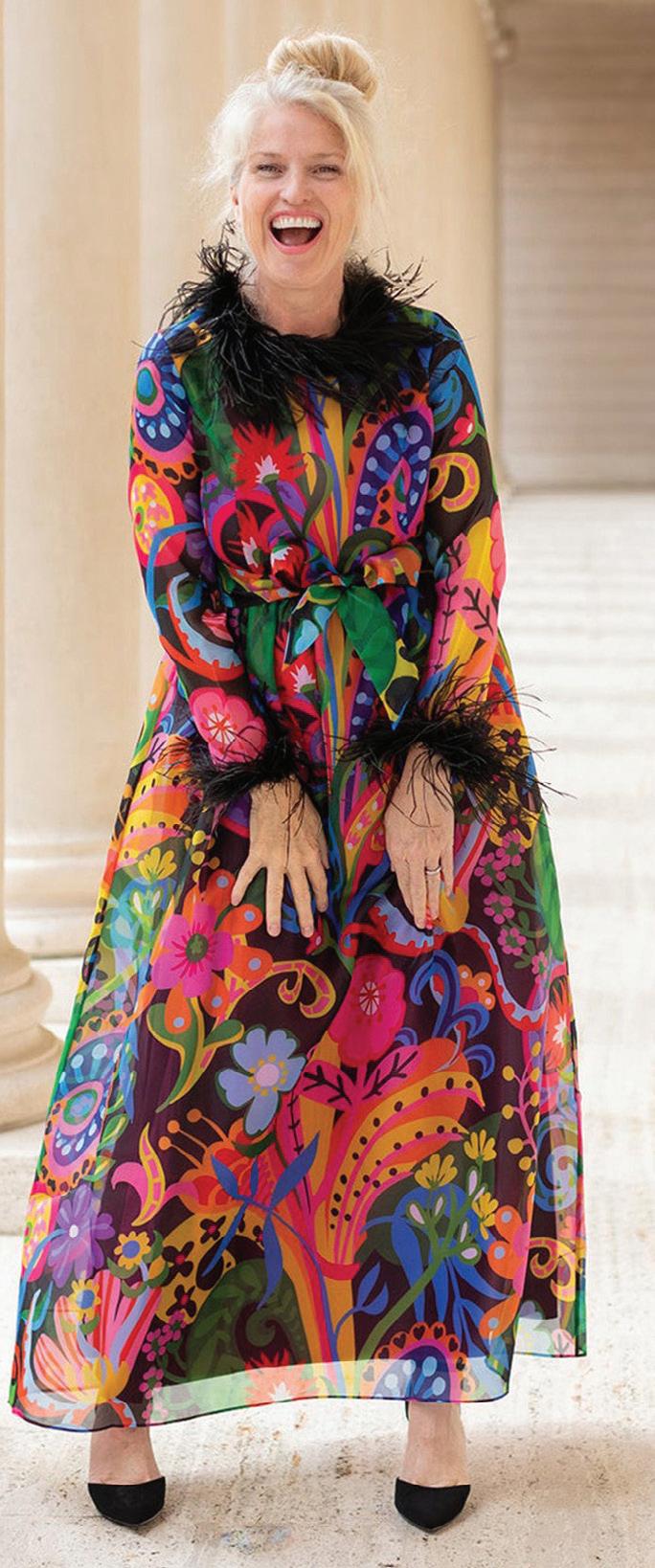
bags that featured wooden handles and removable cloth covers is new. “They’re a throwback to my middle school days, but I worked to make ours stand up and not floppy,” Evers explains. “With each order when we launched in June, you got two prints, one solid, one not. They sold out immediately, and we stopped advertising them until recently because people were getting impatient waiting for delivery. That’s no longer true, and they are popular for fall and gift-giving.”
Other fall-focused innovations are the Spencer, a raincoat in sea glass print with a matching umbrella; capes with matching pants; short and long pajama sets and bathrobes; the Emma sweaters, and bedding and homeware—everything from sheets to duvet covers to mugs, tumblers, aprons and beyond. Belts in several colors come with custom buckles featuring paired frogs, birds or clamshells that nestle and clip together.
Specific to the holidays, Evers highlights a new line of party apparel and gowns. Party dresses with black feathers on the wrists add subtle, festive expression. Long-sleeve T-shirts styled with similar feathers can be paired with low-to-theground, pleated maxi skirts in organza. “You can wear just the solid T-shirt with any of our skirts or jeans, or do the whole setup for dressier occasions,” she suggests. The eye-catching black and fuchsia Arabella gown clings to the torso before flowing in layers like water and arrives in an enlarged, classic filigree pattern.
jewelry and boisterous or sophisticated tights, scarves, capes and jackets.
Evers likes to design sets, with matching tops and bottoms that pull a whole look together. Alternatively, the sets can be split up and paired with different items to achieve additional looks. The Blair blazer and matching Audrey cropped pant project a sleek, especially modern ensemble in black, red or olive check patterns. It’s easy to imagine switching out the jacket or pants with various shirts, pants or skirts.
A collection of handbags modeled on the round or oval-shaped 1970s Bermuda
Looking into her crystal ball while aware of market challenges that include tough regulatory rules, the ever-escalating price of real estate, swiftly changing technology for retail and e-commerce, and keeping price points manageable, Evers still manages to find hope. The new store in Palo Alto feels like “the right move at the right time,” she notes. Furthermore, the wholesale market is greeting the line with open arms. And by blending local and overseas processes, she’s holding the prices steady.
“We reach profitability and stability by expanding our market share, not by raising prices,” says Evers. “I want our clothing to be affordable and also fun, well-fitting and diverse enough to appeal to a broad customer base.”

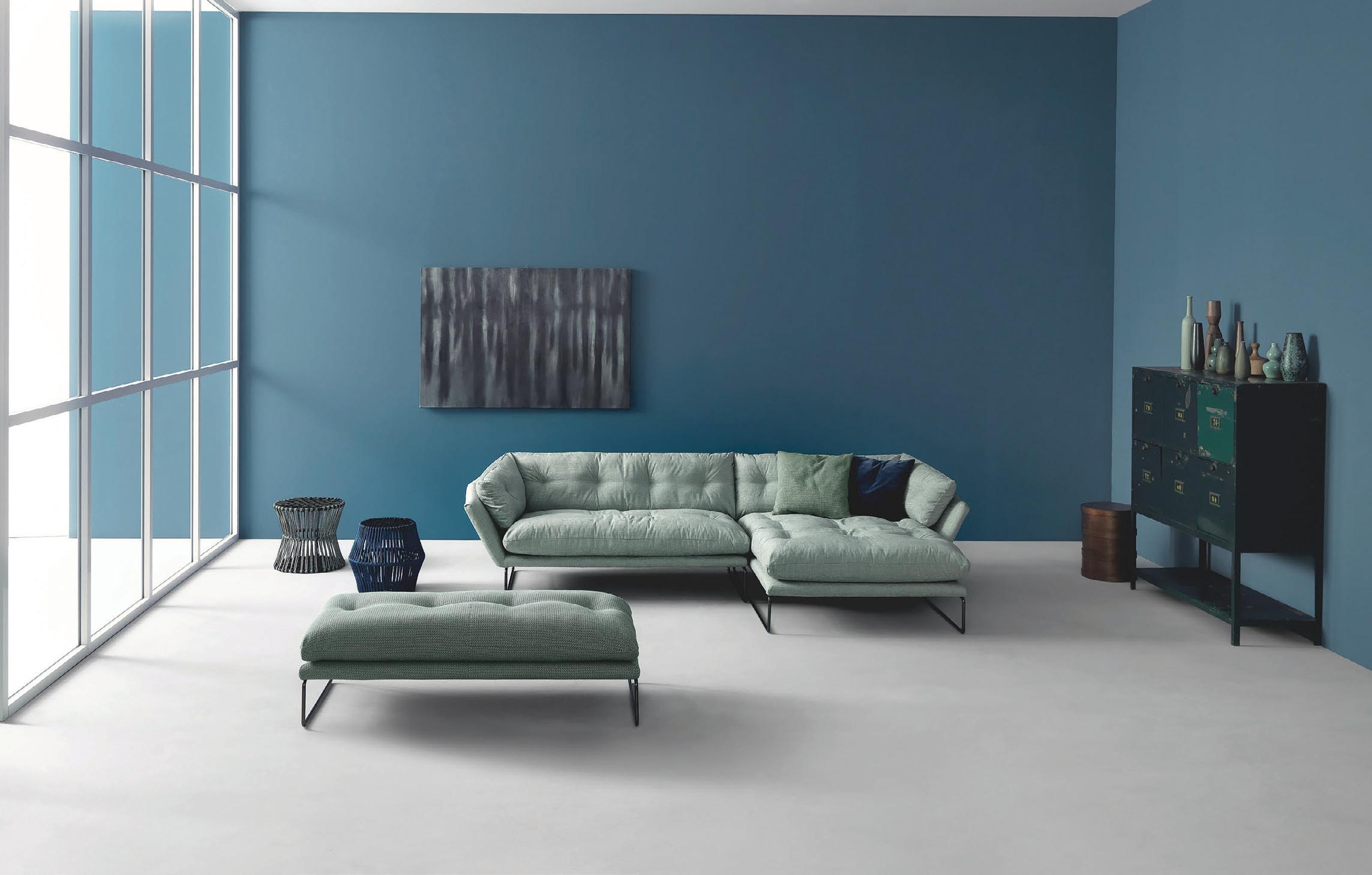





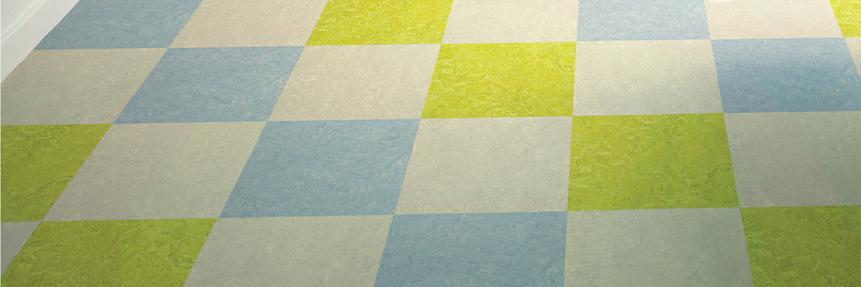











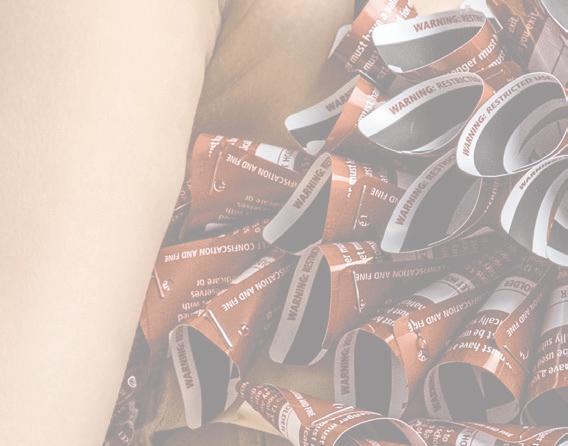
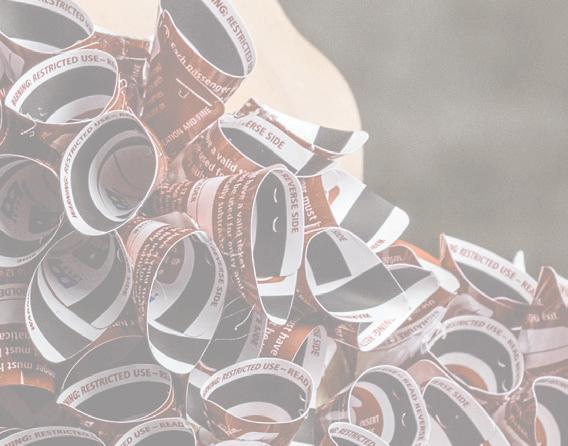
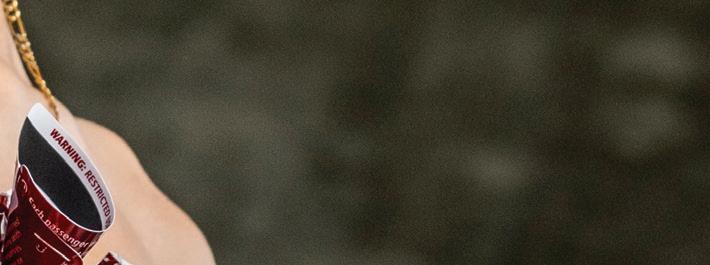




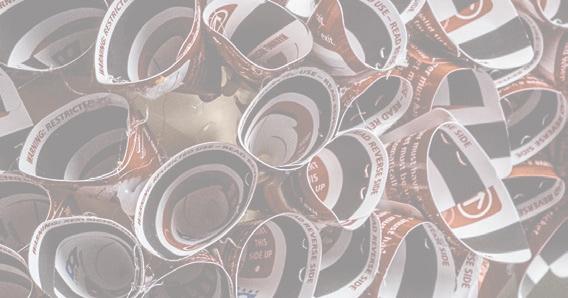
BY Janis Hashe


BY KARL

Coco Chanel’s famous aphorism, “Fashion changes, style remains,” is as true as ever. Images from bygone eras often include one person clad in an outfit that stands the test of time.
Here are three very di erent East Bay people who make, as well as exude, style. What they have in common are vision for detail, a willingness to ignore trendiness, and confidence that what they create and wear is uniquely them.
Seventeen-year-old Reyhana Shephard loves her classes at the Oakland School for the Arts so much, she makes the commute from Vallejo on BART five days a week. So when her instructor, and chair of the fashion department, Stephanie Verrieres, told her about “Project Doneway,” a design contest sponsored by BART, she was all in.

“BART came to us with this crazy idea,” said Verrieres, of challenging students to create high fashion out of the no-longerused-but-fondly-remembered BART paper tickets. Several trips to BART central to pick up boxes of tickets later, students, including Shephard, were ready to design.
Her dress, called “BART of Hearts,” used over 1,000 tickets; took many hours to create, including its carefully

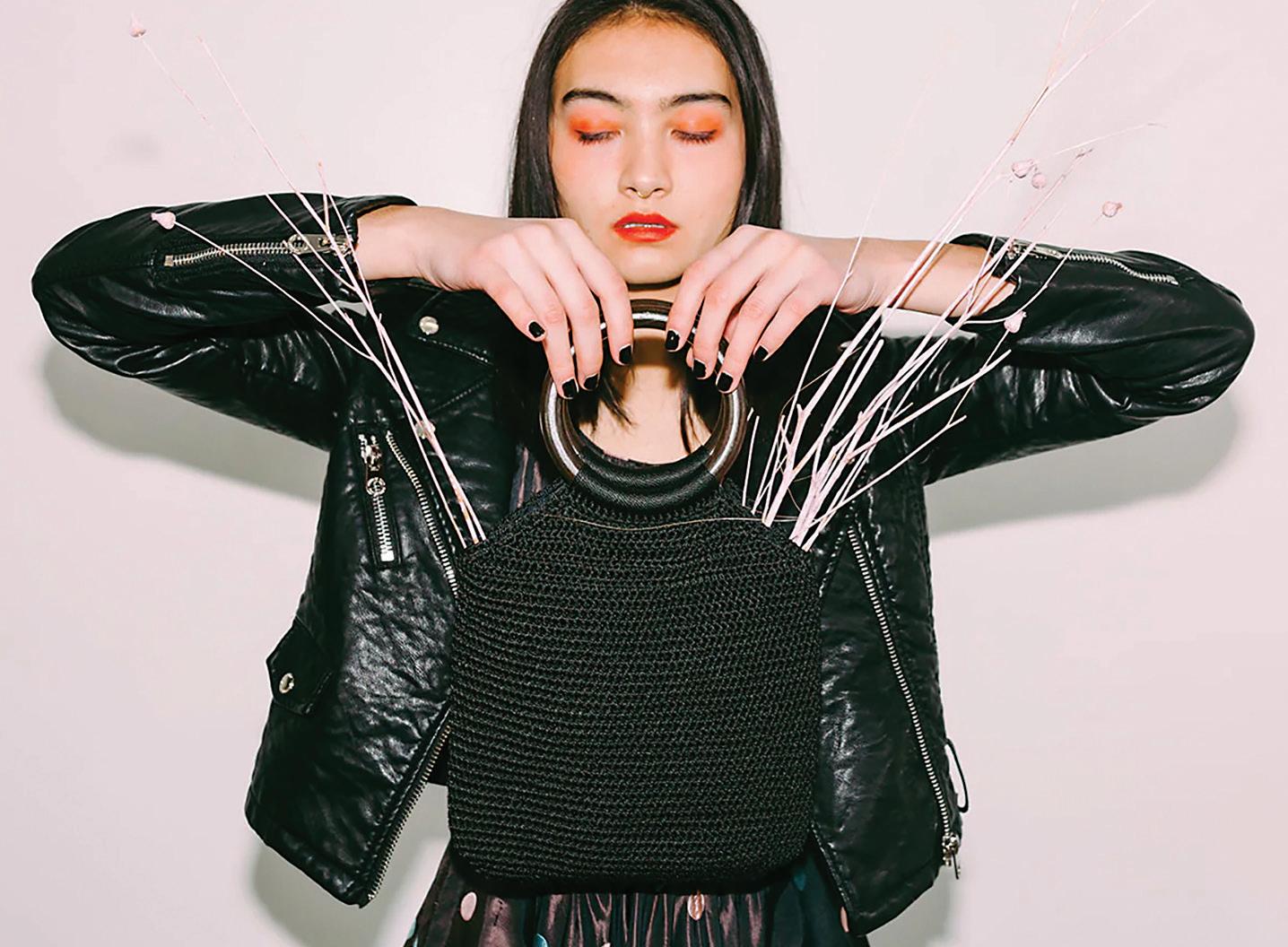
constructed paper corset and cage skirt; and was inspired by the Queen of Hearts in Alice in Wonderland, as well as Victorian-era undergarments. Dazzling the judges, it won first place in the highschool category of “Project Doneway.”
Verrieres wasn’t surprised. In her years of majoring in fashion design, Shephard had impressed with her dedication. Even being accepted into the OSA program is very competitive, with students required to submit a portfolio. Once accepted, they work hard in a cooperative, but exacting environment.
“I’ve always made sketches, since I was in sixth grade…I looked at magazines, paid attention to clothing and how I dressed myself—then I found OSA,” said Shephard. For “BART of Hearts,” she combed through books, and depended on supportive fellow students, as well as Verrieres, for construction advice.
“I felt we needed to win something,” Shephard said. When her design, modeled by Jeylei Hernandez, won on Sept.14 in the Rockridge Station parking lot, she thought, “Oh my goodness; I did that!”
traditional fashion design. The late McQueen, who was trained in tailoring, was known for his convention-breaking designs and continues to be revered by the fashion world.
“Style,” said Shephard, “is personal. It’s not just following trends, but setting them.” Verrieres noted that this is Shephard’s final year at OSA. She will be part of the annual spring fashion show, in which each designer presents their collection, taking place May 11, 2025.
For more information about OSA, visit oakarts.org.
Sarah Dunbar’s love for classic vintage clothing began in her teens. She got her first job at 22 with Mars Mercantile, and learned how to buy vintage clothes and what “sustainability” meant. After moving to Brooklyn, she worked as a buyer at Beacon’s Closet, picking up more knowledge about labels, fabrics and fit.
Her style icons include designers Elsa Schiaparelli and Alexander McQueen. Schiaparelli, who often took her inspirations from artists like Dali and Cocteau, never hesitated to veer from »
In 2004, back in Berkeley, she transformed her one-bedroom apartment into a once-a-month store. This proved so popular that in 2006, she took the plunge and opened the first version of Pretty Penny Vintage.
Today, after 18 years and several locations, Pretty Penny showcases vintage in Berkeley’s Elmwood district, with Dunbar’s husband’s hair salon operating on the floor above. She continues to offer items with “timeless, versatile style at an accessible price point.”
Uniquely, clothing items are not arranged by size. “Depending on the silhouette, a piece could fit maybe three different sizes,” she said. Her in-depth experience helps shoppers learn “how to size themselves,” and she offers a booklet that explains different silhouettes. She gently disabuses those who have reservations about “used” clothes. “Designers copy these styles all the time,” Dunbar said.
Returning customers tell her things such as, “I just wore a dress I got from you 15 years ago.” Current pieces range from a deep-blue Victor Costa two-piece dress, to a 1950s sleeveless print-with-sequins full-length dress, to a silver metallic brocaded ’60s mini-dress.
But Dunbar has noticed a trend she hopes to turn around. When she opened Pretty Penny, her customer age range was “12-to-90,” she said, and it’s contracted to more like 25-to-75. She feels that the influx of “fast fashion” is more influential than the trend to upcycling and sustainable fashion. That, however, may change as younger buyers come to realize that quality lasts.
Asked, “What is style to you?” Dunbar said, “Comfort. If it feels like you, you will wear it, whether it’s a wider leg or a high waist.” She cited a favorite customer, a jewelry designer, who works in brightly colored plastic, and likes to dress in ways that complement her creations. “I love her playfulness,” said Dunbar. “Personal style is both comfort—and joy.”
prettypennyclothing.com
In 1984, Lisa Lowry was merchandising in the new Beverly Hills Banana Republic. This first BR outside of the Bay Area was like a movie set: a 1940s Stinson plane hanging from the ceiling, a 10-foot fiberglass African elephant bursting out
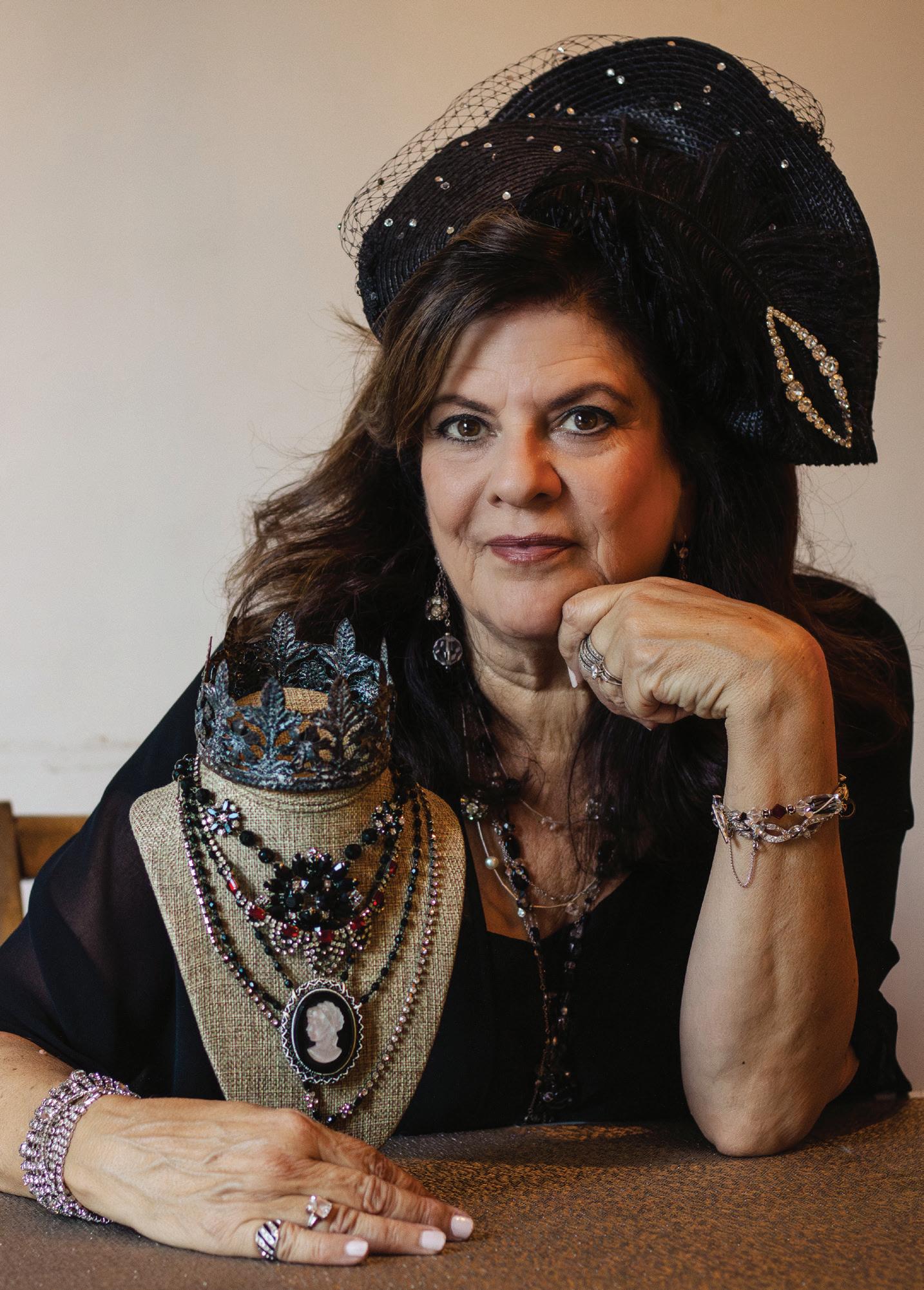
of the back wall, a Quonset hut dressing room.
East Bay native Lowry had gotten used to celebrities sauntering through the doors. But with “Cheek to Cheek” from Top Hat playing over the sound system, she did a double-take as Fred Astaire walked in. Putting his hand on her arm, he smiled and said, “Gee, I didn’t think anyone played this song anymore.”
It was the ’80s, glam, big hair, glitter— and, at BR, “safari chic.” Lowry, who had modeled as a child for Children’s Hospital Oakland benefits, and acted at the Contra Costa Civic Theatre, found her conservative style morphing into a glorious cross between rock and roll and Old Hollywood.
This transition was facilitated by what became a lifelong friendship with »
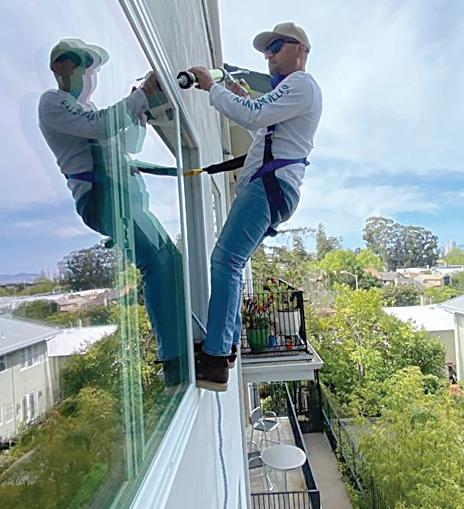






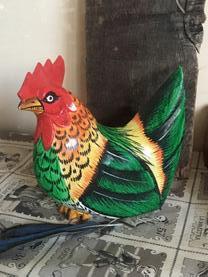

— SARAH DUNBAR
Pretty Penny
fellow BR employee, Louisa Voisine, who was pursuing a fashion design career. Voisine, now a couture milliner in Las Vegas, used Lowry as a model for in-store and other fashion shows. “Louisa mixed ‘Old Hollywood Legend’ crushed velvet with Spandex snakeskin pants,” Lowry (now Ihnken) remembered.
Later, Lowry explored her own selftaught design skills, working with another friend to create jewelry and embellished glass bottles, which were sold in Nina Segal’s shop within legendary fashion retailer Fred Segal. By 1999, she had returned to the Bay Area. She married, became Lisa Ihnken, had a daughter and moved to Kensington.
Her jewelry design was mostly on hold until her daughter entered high school. Then, she began taking quality vintage jewelry, or often pieces of it, and reconfiguring them into new, original pieces. By 2011, she was creating for consignment customers, and in 2018, she opened her Etsy shop, Heavenly Fragments.
“I only use quality materials in excellent condition,” she said, noting that 1960s costume jewelry companies, such as Monet and Trifari, used high manufacturing standards, “and their pieces have held up.”
Ihnken still loves the contrast and complement of rock and glamor, both in her work and personally: Hepburn in Givenchy in Breakfast At Ti any’s, but also Cher in Bob Mackie. Style, she said, “is about how you put a look together in a way that no one else could.”
heavenlyfragments.etsy.com
BY Brooke Mohiuddin

ANDIE PATTERSON, a drama teacher and theater costume designer at Head-Royce School in Oakland, is someone who can always be counted on to light up a room with her cheerful personality and colorful attire. A style as creative and uniquely chic as Patterson’s cannot be bought o the rack. She sports truly eyecatching handmade and vintage-sourced outfits daily. For those looking to develop their personal style, Patterson shares tips based on her fashion journey.
Patterson’s style has developed by focusing on what makes her feel the most confident, even despite current trends. One of her main tips is to not be afraid to try things. In high school, she discovered her love for high-waisted pieces, even though they weren’t popular at the time. Since then, she’s taken inspiration from the ’70s with things like flowy fabric, bold patterns and fun colors, as well as actresses Maya Rudolph and Tracee Ellis Ross.
“I’m always going to like something that I find secondhand more than something I buy new,” says Patterson. “There’s something about the specialness of it, the uncommonness of it, and the e ort that goes into finding it. It’s like putting together a vibe, or curating a museum. I can show my taste and my interests by these things.”
Patterson’s favorite local places to shop vintage include the Alameda Point Antiques Faire, Pretty Penny in Elmwood and Goodwill. When sewing clothes, she often thrifts fabric, or uses pre-existing pieces. It’s better for the environment, and gives the garment a new life. Her advice for folks interested in sewing is to find someone to teach it, and not go completely solo, because people are usually excited to pass down their sewing skills—just like Patterson does for her students. ❤


Cognitive decline can steal the past, but it doesn’t have to steal the future. Pioneered to curb the effects of cognitive decline, Circle of Friends® is a unique, evidence-based program for building brain fitness. It was developed by Belmont Village in collaboration with the nation’s top universities and healthcare institutions — and it works. Residents enjoy a rich, therapeutic program of physical and mental activities designed to maintain brain function and build self-esteem.




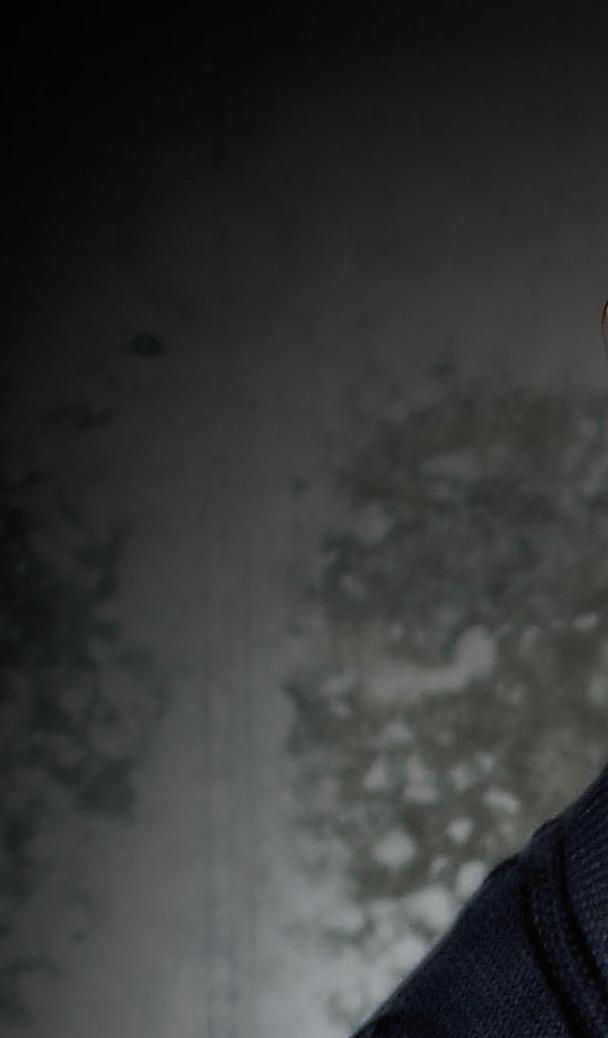

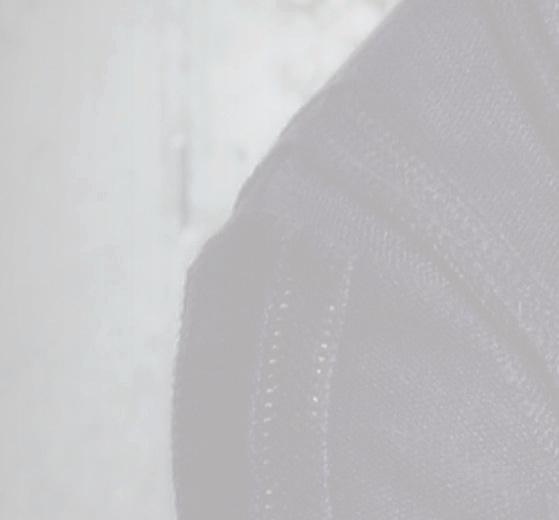


Oakland guitarist Jubu Smith releases bravura solo debut, won’t talk about it
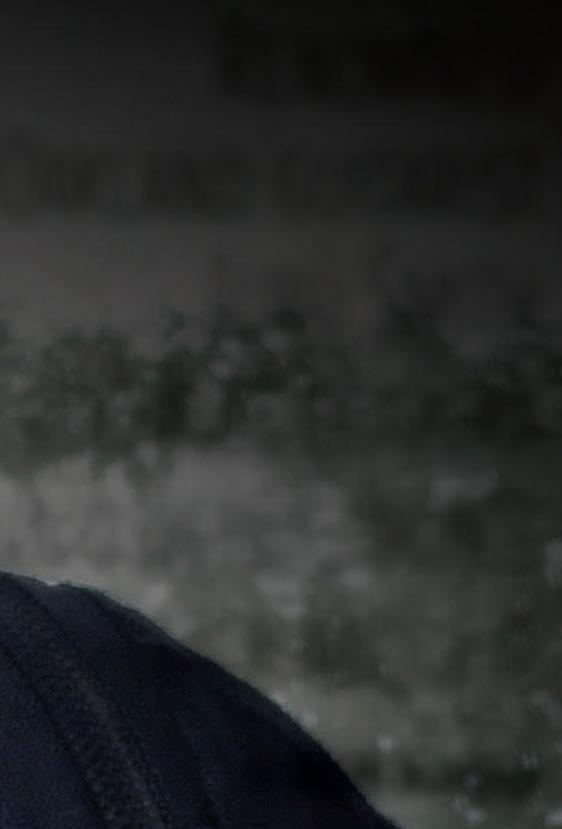
BY Bill Kopp



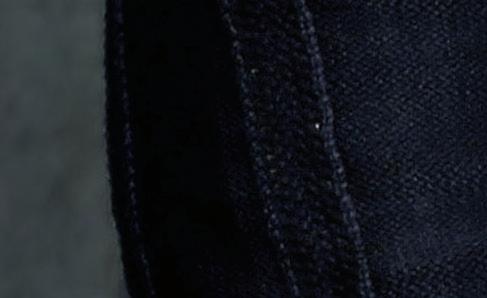


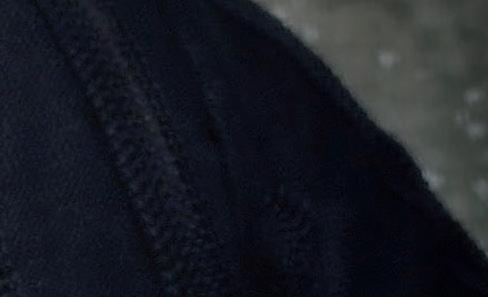






Jubu Smith has made a career out of applying his considerable talents to the creative pursuits of other artists. The Oakland-born guitarist got his start in church, honed his craft and landed gigs working with some of music’s biggest names.
Starting in the early ’90s, Smith spent most of the next several decades in a kind of balancing act: backing high-profile artists onstage and on hit recordings, yet toiling in near-anonymity. Smith is well-known and revered in the music community. But to the wider public, mention of his name often draws a blank stare.
That could—possibly—change with the release of an album called Jubu Released on the Little Village label—an arm of the nonprofit Little Village Foundation—Smith’s self-titled debut album is a showcase for his astoundingly wide-ranging stylistic vision. Created in collaboration with two other esteemed musicians, Jubu is an instrumental tour de force. But it’s fair to wonder: Why did Jubu Smith wait nearly three-plus decades into his recording career to make an album of his own?
The answer may have something to do with Smith’s apparent disdain for self-promotion. Certainly he has given
interviews over the years, willingly discussing his role in the careers of Maze Featuring Frankie Beverly, Tony! Toni! Toné!, Whitney Houston and others of note. But when it came time to promote Jubu—released worldwide July 30—the artist had gone to ground.
Fortunately, Jubu Smith has spoken on the record a few times, and close associates on his latest project—guitarist Charlie Hunter, label head Jim Pugh—were more than happy to speak about their work with the man.
Smith’s father was a guitarist; he led a gospel group called the Soulful Sons of Zion. “My dad was my hero,” Smith told podcast
host Josh Smith (no relation) on Live from Flat V Studios in 2021. “Had he been a boxer, that’s what I would be today. Had he been a basketball player, that’s what I would have been trying to be,” he explained. “Luckily for me, he played the guitar.”
Jazz training during high school opened up Smith’s musical vocabulary. His first paying gig as a guitarist was a weekly date at Yoshi’s, when he was only 15. As he grew toward young adulthood, he played weekend gospel gigs, all the while dreaming of making music a full-time endeavor. Often playing in groups without a keyboardist, Smith developed a style all his own that lessened or even eliminated the need for other melodic instruments.
During that 2021 podcast interview, Smith revealed that upon graduation from high school in 1988, he had been accepted at the prestigious Berklee College of Music in Boston—with a full ride, even—but he turned it down. “I don’t want people to tell me how to play,” he explained.
Instead, he stayed busy as a working musician. Raphael Siddiq soon hired him as guitarist for his group, Tony! Toni! Toné! Not only was Smith playing highprofile gigs and making good money, but his phone was constantly ringing with o ers to play on other artists’ sessions. He pursued many of those opportunities, playing on dozens of recordings for artists in and beyond r&b and pop.
When Siddiq left Tony! Toni! Toné!, Smith decided he was done as well. He auditioned for Whitney Houston’s group, and ended up touring with the singer through 1999 and 2000. During that time, Houston also encouraged Smith to pursue his own path. But before he had a chance to do that, Frankie Beverly called and invited him to play with Maze. Along with continued session work, that gig would keep him busy for many years.
The bills were getting paid, and Smith had cultivated a sterling reputation as a first-call player. In the 21st century, he launched a gospel-blues group called Legally Blynd, recording and releasing a pair of albums. But there was still something missing. “I tell this to myself all the time,” he said in 2021. “There’s no reason why I shouldn’t have 10 albums under my name.”
All he needed was to be discovered.
‘Way back then, it was his feel.
great stroke and great chords.’
—JIM PUGH
“‘Discover’ is the wrong word,” says label head Jim Pugh. In fact, he had known the guitarist and his family for decades. “Back in the ’80s, I played in a gospel quartet in Oakland, the Gospel Hummingbirds,” Pugh recalls. “The scene in Oakland was tight-knit. Everybody knew everybody: The Sons of Zion, Omega Aires, Spiritual Corinthians… on and on.”
Pugh was impressed with Smith from the start. “Way back then, it was his feel. A great stroke and great chords,” he says. “And at some point, I learned he was the heir to the gospel quartet guitar throne held previously by Spanky Alford.”
Fast forward to the 2020s, with Pugh now in a position to help bring Smith’s talent to a wider audience. “I asked Charlie Hunter to ask Jubu if he wanted to do an album,” Pugh explains. “Because who’s going to say no to Charlie?”
Guitarist Charlie Hunter is himself a highly sought-after instrumentalist. A prolific artist, Hunter has released three dozen albums under his own name, taken part in dozens of collaborative projects and produced or co-produced more than 40 albums. His work e ortlessly transcends genre; Hunter’s extensive credits include work in The Disposable Heroes of Hiphoprisy and Garage a Trois, as well as SuperBlue with jazz singer Kurt Elling.
These days, Hunter lives near Greensboro, North Carolina. But back in his younger days, both he and Smith were based in the Bay Area. “Both of our careers were going crazy,” he recalls. “So we never really hung out, because we were always on the road.” But Hunter has long counted himself a serious fan of Smith’s artistry.
Hunter is also the inventor and developer of the Hybrid Guitar. And that instrument provides the ability for a
skilled player to handle lead, rhythm and bass guitar parts on a single instrument. In Hunter’s hands, the Hybrid Guitar is a sort of co-star on Jubu
Smith’s debut album is a musical travelog, an audio document of Smith’s wide-encompassing musical worldview. While tracks like “Hamster Wheel” sport a deep groove funk vibe, there’s a soulful Wes Montgomery feel to cuts like “Jubu’s Poem.” The bouncy “Carroll Drive” leans toward a countrypolitan sound, and “Extreme Pleasure” is knotty, expressive blues. A Smith solo spotlight, “At Long Last,” is a sublime flight of jazz fancy.
Remarkably, while there’s a tightly composed feel to all of the album’s 10 original tracks, every single cut is the product of real-time improvisation. “We didn’t come in with any material,” Hunter admits. He says the explicit goal was to tell a story without words. “We just got together… and played.”
Hunter had high hopes for the sessions at Greensboro’s Earthtones Studio, but even he is astounded by the results. “There’s an insane lot of guitar records,” he admits. “But there aren’t people out there like Jubu, with that phrasing, that lineage and that deep history of the guitar vernacular.”
Jim Pugh and his label are doing what they can to get the word out about Jubu. Pugh enthuses about the “one time—and one time only—organic nature of the improvisation.”
Charlie Hunter will rave about it to anyone who’ll listen. “I felt it was important to make this record,” he says. But after recording and releasing the superb and wordless Jubu, the album’s namesake is ultimately leaving the music to speak for itself. ❤
BY

BY Lisa Plachy
Oakland’s vintage shops may be one-of-a-kind, yet many have similar beginnings. Karen Fort, owner of Mercy Vintage in Rockridge, attests: “There’s a lot of origin stories that start like mine.”
Her mom was an antiquer, she says, and Fort began “treasure hunting” seriously after volunteering at a thrift shop during high school. She became obsessed, starting to collect pieces she loved, then buying and selling them as a side job. A teacher at the time, Fort recalls the cycle took over her life until she had to make a call.
“I either needed to go for it or just quit it,” she says. She went for it, opening up a small shop in Berkeley, then Mercy Vintage’s original location 15 years ago.
The formula—the hobby to storefront pipeline—is a common refrain. At Serial Material in West Oakland, shop owner Jeanette De Mello used to go vintage shopping with her grandmother. She and her business partner, Jackki Gude, spent the past decade “slinging suitcases” and selling clothes on Etsy.
Lou Lou Rosenthal says she and Kylee Kienitz, who are co-owners of Heads or Tails Collective on Piedmont, have been “collectors slash hoarders since we were young,” and met selling their stashes in pop-ups across the bay.
Today, they all remain dedicated to the genre with the same fervor that hooked them in the first place—in a time when vintage has never been so loosely defined and in demand.
First, a brief vocabulary lesson, to differentiate between the terms “vintage” and “secondhand.” Caveat: The definitions are debatable.
“Technically ‘vintage’ is anything 20 years or older, and ‘antique’ is anything 100 years or older,” says Fort of Mercy Vintage. OK, that’s clear. “But all the rules have been erased, and I love it.”
Ah. That leaves the current trove of trending Y2K clothes qualifying as vintage, a wildly uncomfortable idea for people who wore those trends and prefer

not to acknowledge that was 20 years ago. (Editor’s note: Present company included.)
“Nowadays, vintage can mean anything up until the mid-2000s, which, to me, feels like a stretch of the term,” says Rosenthal of Heads or Tails.
At Serial Material, De Mello takes a similar stance. “I don’t consider 2021 vintage,” she says. Furthermore, “Secondhand clothing seems to be more for people doing their own selling out of their own closets. It doesn’t necessarily involve a store.”
That’s exactly the realm Iluka Enright, founder of Seconds Market, wants to occupy. The recurring pop-up market, where people can purchase space to sell racks of their own clothing, focuses on
the term “secondhand” so exclusively it’s built into the name. Enright wanted to fill the gap between donation options and consignment store selling to provide a better option for “real people” to deal with clothes they no longer want. Her model is a piece of a vastly growing market.
Spurred by the pandemic, shop owners say, the broad category of thrifted clothing— that is, used clothing, whatever its label— has seen a huge surge in demand. A 2024 report from online consignment shop ThredUp expects the U.S. secondhand apparel market to reach $73 billion by 2028. While this has been mostly

good for business, the swell has skewed vintage valuations in the process.
“Since vintage got really popular,” says Rosenthal, “I’ve seen things selling for amounts that feel really unattainable.”
Fort echoes this phenomenon, saying some vintage clothing has reached an “insane stratosphere of cost.” These concerns largely revolve around hyped-up, high-end designer pieces.
Conversely, not all customers understand the value of older clothing in a world where mass-manufactured fashion can be called vintage. The pre-1970s styles these shop owners grew up searching for are much harder to source. And since the quality of these goods also rivals its fashion industry successors, they can warrant a higher price that not everyone is willing to pay.
Even with this conundrum, these shop owners seem unconcerned. While they prioritize accessibility in pricing, mostly

they know their customers.
“People seeking it out will pay what it’s worth,” says Gude of Serial Material.
Shop owners universally told me that there is no “typical” customer by demographic parameters. Many focus on making their curated styles as widely accessible as possible instead.
“All we can really hope for [is] that anyone can hop in the store and find something they like,” says Rosenthal. Heads or Tails Collective doesn’t gender their clothes. “If it fits your body and your taste, that’s great.”
Rosenthal says the shop tends to stock bright, bold patterns and psychedelic swirls, aesthetics from the 1960s and 1970s that she and her co-owner are personally attracted to. Serial Material’s shop slogan promises “a look that kills!”





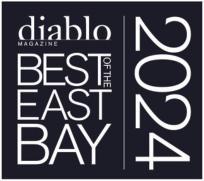














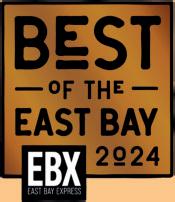



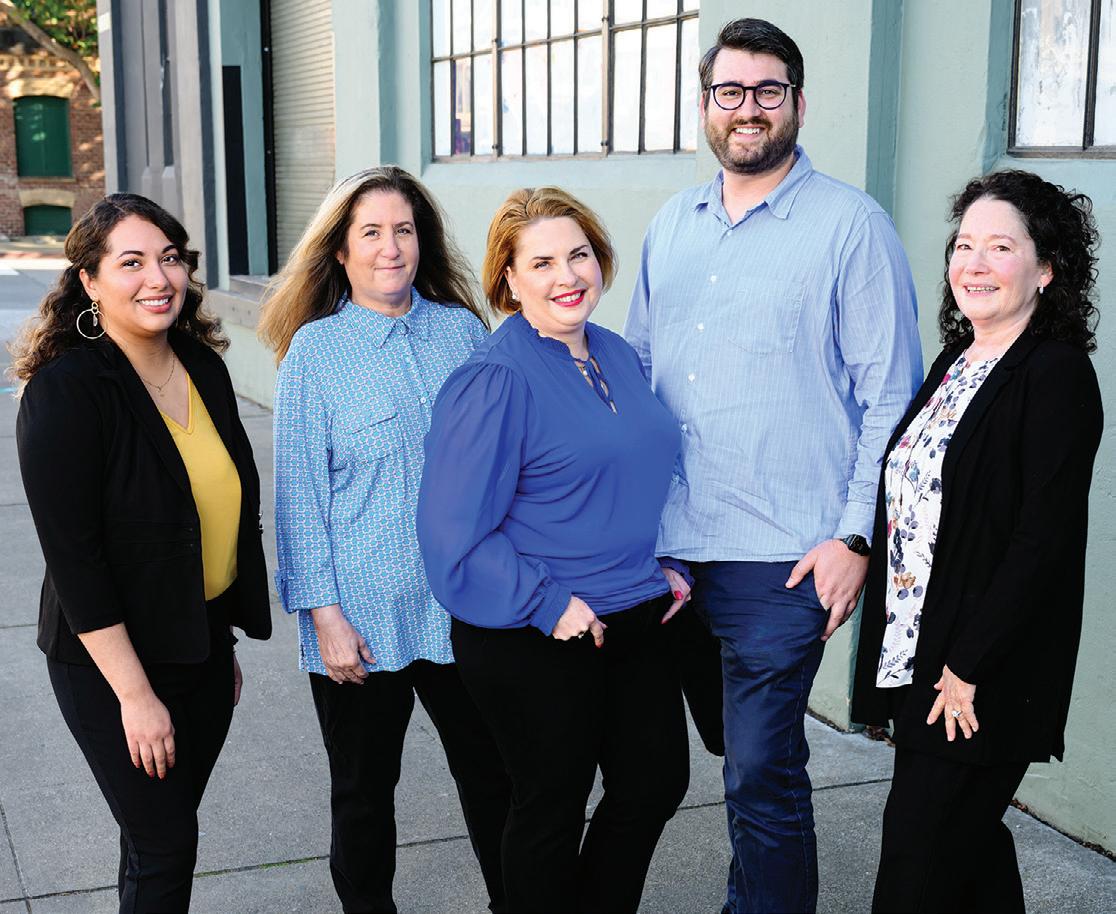

They’re proud to share that their biggest customer is Fantastic Negrito, the renowned Oakland singer-songwriter and three-time Grammy winner who often wears their clothing for his shows in, yes, pretty killer looks.
The two shops also place emphasis on their in-person shopping experiences. Both have opened up new storefronts they hope will attract more foot traffic. While online sales are part of their selling equation, it can be an extensive amount of work to create accurate, detailed posts that don’t always measure up.
“You can provide every measurement you’re going to take, and you still won’t know how it fits until you try it on,” says Rosenthal. “There’s nothing better than seeing someone come out of a dressing room with a giant grin on their face because they found something that fit them perfectly.”
Heads or Tails recently moved down Piedmont Avenue to the former space of Mercy Vintage—which itself relocated to a 3,000 square foot store in Rockridge. Fort shares that online sales have kept pace with in-store ones, in some years even outselling them, with sales coming
in from big markets in New York, Los Angeles and Texas. Inventory moves online or in-person, she says, when everything is rare.
“There’s a kind of built in excitement,” says Fort. “If you see it, someone else is gonna swoop on it if you don’t move on it.”
Selling vintage clothing has always been an occupation for the passionate. For some, what started as a passion for designs or textile has evolved and expanded to recognize the importance of sustainability within the clothing industry, for which vintage clothing is uniquely suited.
“People are really aware of and people are really understanding the detriment of fast fashion on humanity,” says Fort, adding that there’s more of an appreciation for items that last. That’s led her to pursue a new idea, another term in the thrift lexicon: future-vintage.
“Future-vintage” items are made today but to the level of quality that will ensure their longevity. Fort cites Ulla Johnson, Zimmerman and DÔEN
as contemporary brands she carries at Mercy that qualify. It’s also a response to customers asking her to curate unique collections and the expansiveness of what vintage means today.
Keeping items out of landfills, says Rosenthal, is part of their shop’s premise. “One of the reasons we wanted to do this in the first place is we found the styles timeless, but [also] the quality was better.”
Still, there’s nothing like a first love. Through trend cycles and planetary shifts, these shop owners will keep digging through piles and bins and racks and feeds to bring back from history what others have left behind, with a kind of dedication that’s practically sacred.
“We literally go to flea markets every Sunday,” De Mello tells me. “We call it church.”
Mercy Vintage, open Mon–Fri 11am–6pm; 5505 College Ave., Oakland. 510.325.7324. mercyvintage.com.
Serial Material, open Wed 12–7pm, Thur–Fri noon–8pm, Sat 11am–8pm, Sun 1–6pm; 1634 7th St., Oakland. 415.961.7601. instagram.com/ serialmaterial.
Heads or Tails Collective, open Wed–Sun noon–6pm; 4188 Piedmont Ave., Oakland. 510.214.6240. headsortailscollective.com.


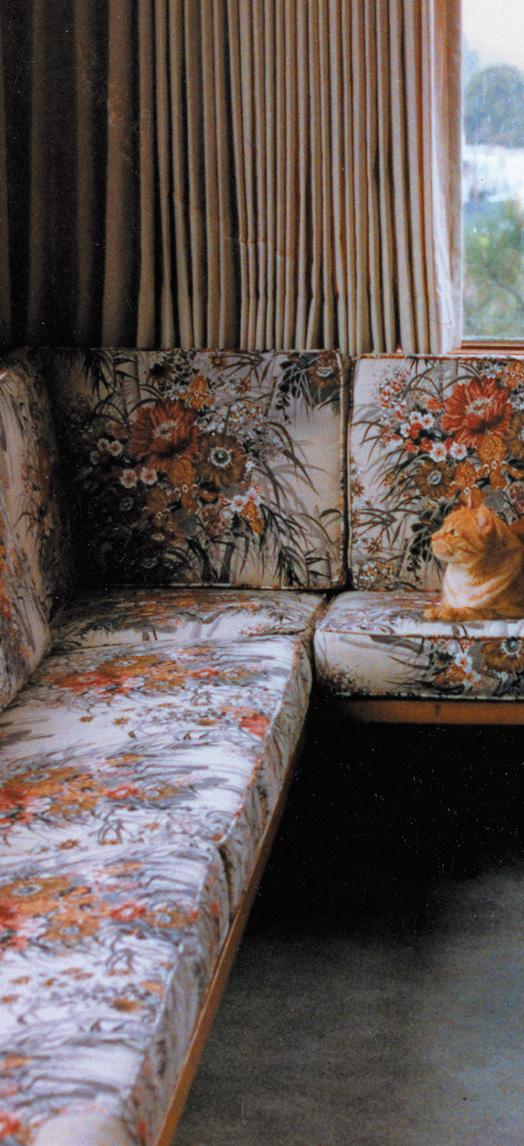


Introducing our premium firewood and charcoal collection - your ticket to flavor-packed, sizzling success this barbecue season! Why Choose Our Charcoal and Firewood? Superior Quality: Our charcoal and firewood are carefully selected for their purity and burn consistency, ensuring your food is infused with that smoky, mouthwatering taste. Meticulously seasoned and split to ensure a clean and long-lasting burn.
Versatile: Perfect for grilling, smoking, or roasting, our products are a must-have for all your outdoor cooking adventures. Our firewood is perfect for your fireplace, wood stove, bonfires, or camping trips.
25616 NICKEL PLACE, HAYWARD, CA 94545 415-467-2972
jandjculinary.com BAY AREA'S CHOICE!










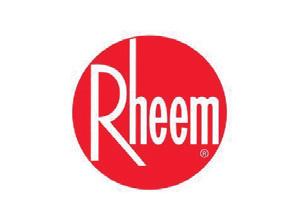

CURIOUS
CREATURE Jane Kim describes the new-to-her ringtail as exotic-looking.

SHY BIRD ‘I feel like I’m playing show and tell,’ says Jane Kim of her work. The belted kingfisher shown here nests underground.
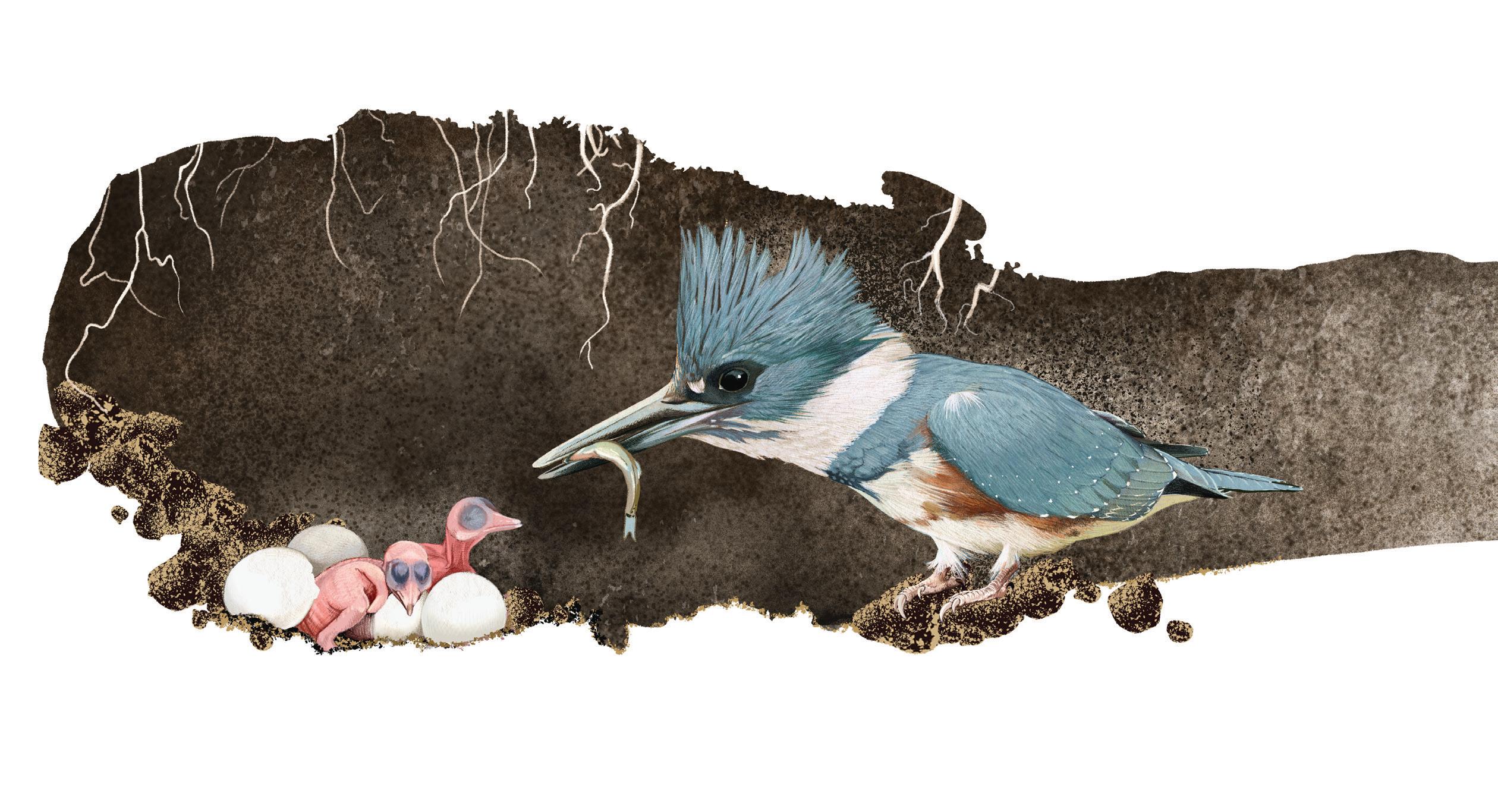
What is seen in Jane Kim’s illustrations is the product of a storied creation
BY Lisa Plachy
Over the past 12 years with her studio team at Ink Dwell, Jane Kim has painted dozens of larger-than-life monarch butterflies, 270 di erent types of birds, entire coastal ecosystems and an endless
completely nocturnal and tends to build its den in hidden places. For Kim, its existence was revealed via one of her favorite assignments—documenting the Bay Area’s diverse array of plants, animals and natural wonders for Bay Nature’s seasonal almanac. The ringtail



these creatures to life. The actual art on the page (or screen) is, if she had to guess, about 20% of the effort.
“[My process] doesn’t actually begin with the visuals, in a weird way,” she shares. “It actually begins with the story.”
This story seeking is Kim’s favorite part—the reading and studying of journals, novels, non-fiction books and scientific collections to get to know whatever she’s trying to depict. She loves the rabbit holes she falls into and the concepts she gets to explore, from the technical to the allegorical, the mythical to the cultural. It is for this very reason
she cannot tell me which California creatures in the almanac have been her favorite.
“Whenever I’m working on a project or personal work,” she says, “the subject of that particular piece is often my favorite in the moment because what I do often requires an in-depth relationship with that particular species.”
I find it telling that, when pressed, she offers up a few examples. One is a nesting scene for the belted kingfisher; another is an illustration of four types of barnacles. Both are elusive—the kingfisher’s nest underground, the barnacles usually glimpsed after they’ve died and dried upon the rocks. Like her
‘What I do often requires an in-depth relationship with that particular species.’
delight in getting to know these species, she finds it rewarding when people share how her work has made them see what wasn’t there before—whether that’s a new animal or a particular detail.
In July, Kim shifted her focus for the rest of the year to a personal project that explores desire. That, too, feels hard to grasp, too big, too abstract. Yet she draws me into her process, sharing tales of the color green, a pigment that could only maintain its permanence in the real world with the addition of a poison.
“If I can get people to desire nature— really go to the lengths that humans will go to when they desire something—that would be a massive win,” she says.
To her credit, I can’t wait to see what she’s been working on. ❤
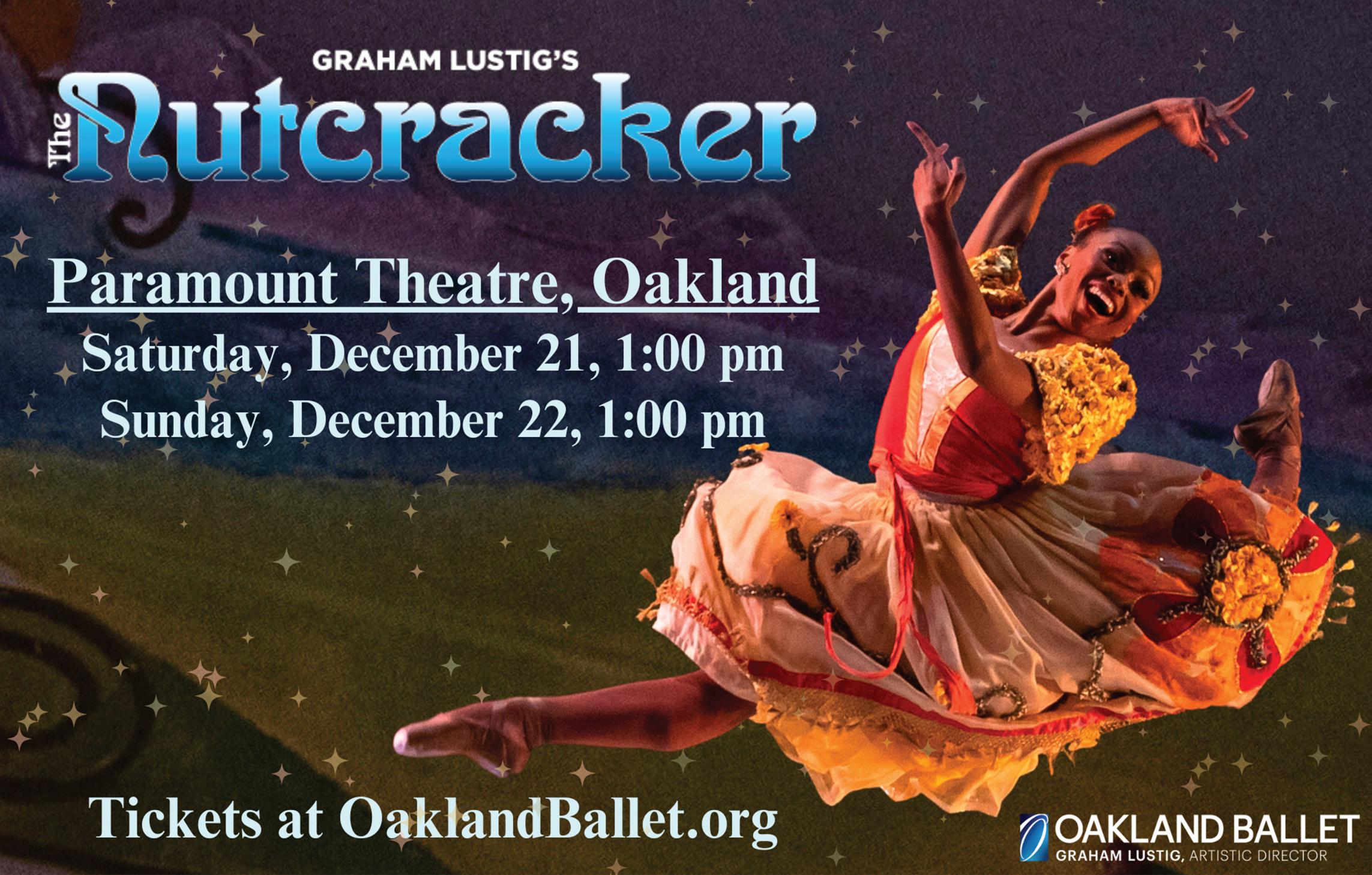





HAPPY ANNIVERSARY
Millennium celebrated 30 years of operation in September at its stylish Rockridge restaurant.





On Thursday, Sept. 26, Millennium hosted a 30th Anniversary celebration.
“Good will towards all” was the unspoken theme of the evening. It felt like a holiday party given by Mr. and Mrs. Fezziwig. The cheerful sta buzzed around the dining room refilling drinks, chatting with regulars and catching up with old friends. A former dishwasher was part of the music trio playing in the corner. Diners arrived dressed to the nines, eager to sip the wine and sample the table of ever replenishing hors d’oeuvres.
Rather than imposing a formal sit down meal on everyone, guests mingled and were free to wander about inside or onto the back patio. At the front of the restaurant, the series of small bites disappeared almost as quickly as they arrived on the scene. A tomato and apple gazpacho soup tasted tangy and only slightly sweet. It was like taking a bite out of the color red.
Lettuce wraps contained the unlikely combination of clamshell mushrooms, gigantes beans and avocado. I would have subtracted the mushrooms and added some crunch. Radish, perhaps, or a bell pepper.
BY Je rey Edalatpour
An encrusted ball of arancini, with corn miso butter and a puttanesca sauce, was a considerably more substantial dish that complemented the more ephemeral ones. Thirty years ago, vegan and vegetarian restaurants were culinary outliers. For confirmed carnivores and omnivores, they promised earnest tofu-forward meals covered in excessive amounts of alfalfa sprouts and served with a side of butterless brown bread. Millennium executive chef and co-owner Eric Tucker didn’t set out to challenge any of those stereotypes. But he understood that a plant-based menu appealed to a niche audience.
As the benefits of plant-based diets gained traction in the ensuing years, Millennium continued to develop a following among vegans and non-vegans alike. Nowadays, Tucker describes the cuisine he makes as “California casual.”
The meals are seasonal, which means the menu changes regularly. He explained that, “We’re pretty much an old school restaurant with appetizers and entrées. We don’t fuss over very small courses.”
Tucker believes that Millennium diners have appreciated the fact that the kitchen has resisted the use of fake meat products.
“You’re going to see a potato cake sitting over a bunch of lobster and oyster mushrooms,” he said. “You might get
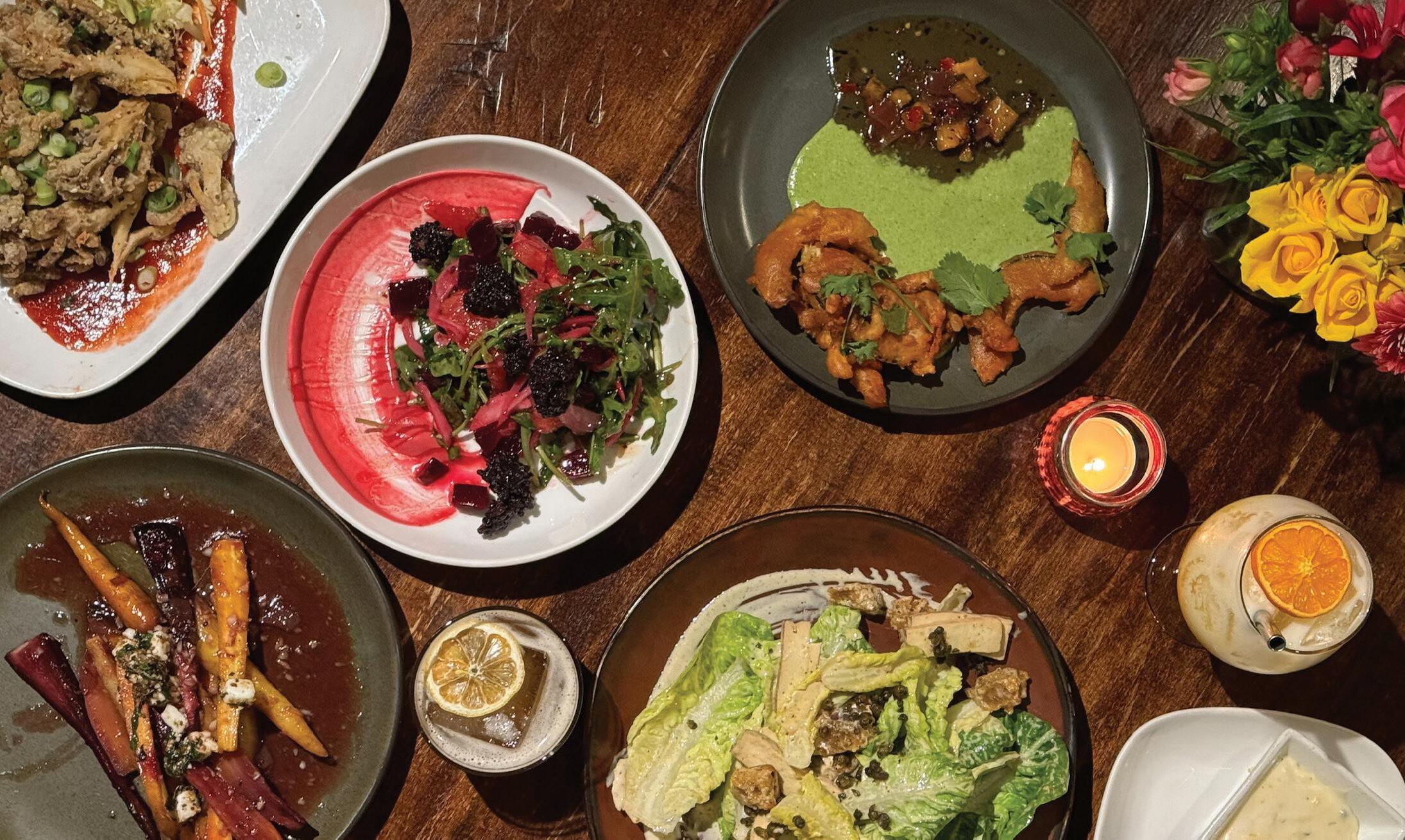
the suggestion of seafood because it’s got a little sea bean salad with nori dust.”
People have also appreciated the restaurant’s farm to table approach.
“We were one of the first ones to go to farmers’ markets to buy produce directly from farmers,” Tucker recalled. Some of the same farms have been open as long as Millennium. The chef also attributes the restaurant’s longevity to a range of special events. “As far as I know, we’re still the only restaurant that does an all chili pepper tasting menu,” he said. And, in August, they hosted over 160 people for an all tomato dinner.
Millennium was reborn from the ashes of Margaret Malone’s San Rafael restaurant, Milly’s. In 1990, Tucker secured an internship there through his culinary program and loved the vibe.
After Malone closed Milly’s a couple years later, Tucker found investors to restart the restaurant with a new moniker in San Francisco. Millennium moved to its
current Rockridge location in 2015.
Before Alison Bagby was hired at Millennium in 2007, she had decided she was finished working in the restaurant business. By the time she moved to San Francisco, Bagby had already worked at upscale plant-based restaurants in Portland, Oregon and Los Angeles. “I was moving in a different direction, but I saw that Millennium was hiring,” she said. After trying plant-based food on the East Coast, she felt that the restaurant was serving the best food of its kind in the country.
Bagby is now Millennium’s director of operations and co-owner. She believes a crucial element of the restaurant’s enduring success is chef Tucker’s menu, which is inspired by cuisines from around the globe.
“Eric’s creative talent as an amazing chef is underappreciated—at least in the press,” she said. “There aren’t many restaurants where you can choose something Italian, or South American. You have so many
flavor profiles on the menu that satisfy a lot of people.” Guests who’ve been coming in for many years have told her that the food continues to get better and better.
The 30th Anniversary celebration was an opportunity for friends and family members of Millennium’s staff to gather together alongside a devoted community. For many years, Bagby’s kids grew up in the restaurant while she was working her 14-hour shifts there. Miyoko Schinner, vegan chef and cookbook author, showed up too, which was one of the highlights of the party for her.
“There was a lot of appreciation for the restaurant in one room,” Bagby said. “We don’t have a lot of employee turnover, and it feels like a kind of family. We’re lucky to have the people we work with.”
Millennium, open Tue-Sat 5-9pm. 510.735.9459. 5912 College Ave., Oakland. millenniumrestaurant.com. IG: @millenniumrestaurant.

‘There aren’t many restaurants where you can choose something Italian, or South American. You have so many flavor profiles on the menu that satisfy a lot of people.’
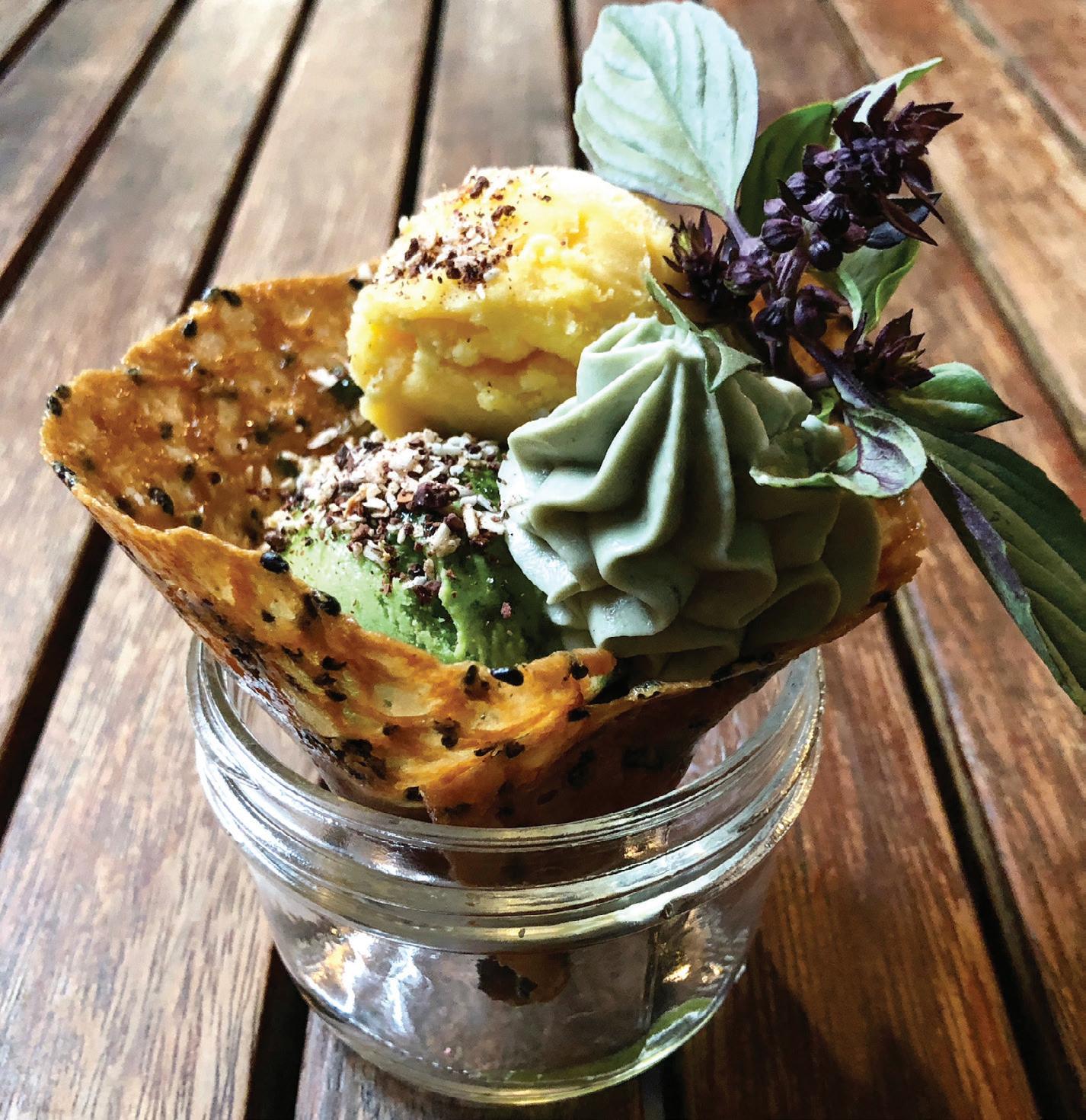


BY Lisa Plachy




The white tru es arrive once a week from Piemonte. By the time this article is published, they’ll be gone, just like the black tru es from Umbria, whose precarious shelf life dictates a twiceweekly shipment. Each variety is flown from Italy to grace the pappardelle at Donato and Co. only when they are in season.
Upon suggesting to executive chef Gianluca Guglielmi that he might use tru es from another region—say the geographically closer Pacific Northwest—I receive a polite kind of sco . One can smell the di erence, he says, all the way from the end of the table.
I’m not sure I’m qualified to make such a distinction, but Guglielmi has several decades of practice. It began with a childhood of grunt work helping his parents run a gastronemia in Conegliano, roughly 40 miles north of Venice, and expanded into a storied career in luxury hotel kitchens and at the helm of Michelin-star restaurants in Italy and Greece. The experiences have led him to form passionate opinions about food: Freezers destroy texture, eggplant isn’t that great, and chicken parmesan will never grace his menu.
Yet the passion that brings tears to his eyes has nothing to do with tru es or ingredients or even the process of creating what he calls “creative Italian cuisine.” That kind of passion is reserved for the people who eat it.
“I believe that when you see happy customers around you, you’re happy,” he says. “That’s, at least for me, that’s the reason why you do this. That’s the purpose of your work every day.”
Today, as Donato and Co. in Berkeley celebrates its seventh anniversary, Guglielmi is perpetuating that happiness, without compromising his culinary vision.
In the early hours of a bustling Thursday night, Guglielmi watches each person who comes through the door into
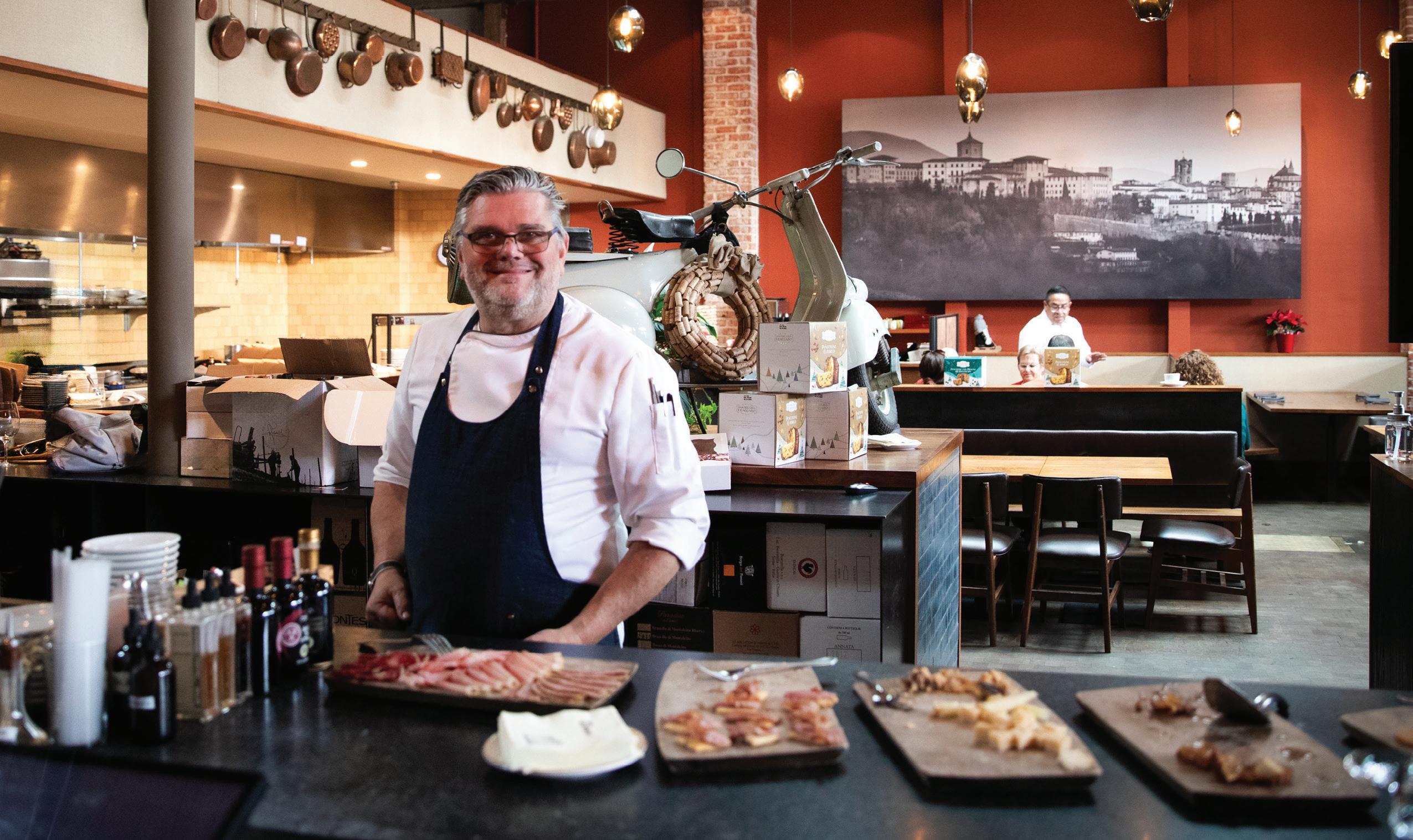
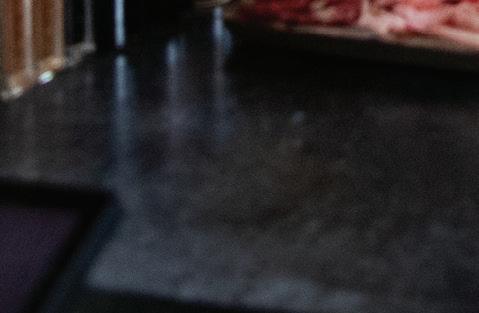
« the restaurant’s open, industrial space. His eyes follow them as he shares with me, sotto voce, their particular quirks.
“This guy,” he says to me, eyeing a guest at a table next to us, “I’m surprised that he’s sitting there.” He gestures, subtly, to the table behind me. “That’s his table.”
Guglielmi shares several examples, going through a mental catalog of his most loyal visitors. And indeed, this guest relocates as soon as “his” table opens. Later, Guglielmi will greet him with great familiarity, as he will many others. While employees a ectionately joke about his conversational nature, it’s clear that it’s core to the Donato and Co. experience.
“You don’t go to a restaurant anymore because you’re starving,” he says. “You go to a restaurant because you need to have the pleasure of going to a restaurant.”
He knows that the food matters—one could eat any ordinary thing—as well as the setting—one could meet someone anywhere. The pinnacle of his work is when he can bring those two elements together, to the point where a customer might reach out to him to share how much they enjoyed themselves.
“Can you get more satisfied than that?
No, how can you?” he says, as his eyes begin to water.
The night I dined at Donato and Co., I first met Guglielmi through his food. My introduction was an almost missable menu item listed in tiny font under four columns of Italian o erings: “ASSORTED HOUSEBAKED
BREAD served with GREEN OLIVE TAPENADE $5.00.”
It arrived a verdant green, the antithesis of the kalamata-heavy, chunky and audaciously salty tapenades of other institutions I believed I had loved. Its taste was pure olive essence. Heavenly.
Next up, an order of baccalà, which typically refers to salted cod. In Guglielmi’s version, it is a light mousse atop a satisfyingly spongy polenta cake bearing proud statues of homemade polenta chips.
Then Guglielmi himself began to arrive with more food.
A charcuterie board with six di erent varieties of beef, pork and duck, all cured in the restaurant’s basement. Spaghetti neri, an umami-rich homemade squid-ink
pasta featuring bottarga, a salted and cured tuna roe. The pappardelle with white tru es I happened to catch in season. Branzino, salted only by the Grecian sea of its former home. For dessert, a pile of eggy sbrisolona e crema with a side of perfectly pale pistachio gelato. With every dish, an origin story, of produce or process or philosophy.
By dish number four, I was ready to give up, so full it was hard to sit still. Instead, I gave in. I gave in to the warmth of Guglielmi and his melodic Italian. I gave in to the languid hours that passed and the Friday night energy that brought people streaming in. I gave in to an old feeling, too, the nostalgia of my family dinners, where we lingered at the tables of old restaurants and enjoyed each other’s company as much as the food.
“At a restaurant, you don’t eat what you love,” says Guglielmi. “You eat what a chef loves.”
And when a chef loves his patrons, one feels it.
Donato & Co., Tue to Thur noon-2:30pm and 5-9pm; Fri–Sat, noon-2:30pm and 5-9:30pm; Sun noon-2:30pm and 5-8:30pm. 2635 Ashby Ave., Berkeley. 510.838.1131.
Garbageisamanufacturedproduct,created whenotherwiserecoverableresourcesare mixedandmashedtogether.Mostroomsin everybuildingin thewholecountry haveabasket wherethis manufacturing begins.Discarded resourcesareput inonebyone, thendumpedinto alargerbin,and thenintoatruck withamore modernbodybasedonthisone.A hydraulicpistonsmasheseverything together.Theobjectiveistopackinmore cargobeforethetruckhastobedrivento whereitcandumpontotheland,tobe covered ina“sanitary“way.Liquidsleach outandmaketheirwayintotheplanet's
Garbage is a manufactured product, created when otherwise recoverable resources are mixed and mashed together. Most rooms in every building in the whole country have a basket where this begins. Discarded resources are put in one by one, then dumped into a larger bin, and then into a truck with a more modern body based on this one. A hydraulic piston smashes everything together. The objective is to pack in more cargo before the truck has to be driven to where it can dump onto the land, to be in a “sanitary“ way. Liquids leach out and make their way into the planet's


water eventually. These “sanitary” methods of filling the land (hence “sanitary landfills”) also provide for anaerobic decomposition of organic materials – which makes
water—eventually.These“sanitary” methodsoffillingtheland(hence“sanitary landfills”)alsoprovideforanaerobic decompositionof organicmaterials –whichmakes methane.
Landfills are the largest source of methane. In the short term methane is 80-100 times
more powerful than carbon dioxide to warm the planet.
Landfillsare thelargest human-created sourceof methane.Inthe shortterm methaneis 80-100times morepowerfulthancarbondioxideto warmtheplanet.
Makinggarbagechangestheclimate!
Ifyou'renotforZeroWaste, howmuchwasteareyoufor?
If you're not for Zero Waste, how much waste are you for?
NASA'sAstronomyPictureof theDayfromFebruary12, 2002,coloredthemethanein theEarth'satmospheregreen, andananimationshowedhowit spinstothepoles.NASAsaid, “Methane(CH4)issecondonly tocarbondioxide(CO2)in creatingawarminggreenhouse effect…. ThelargestabundancereleasedbytheUS…is createdwhen anaerobic bacteriabreakdowncarbon-based garbage inlandfills.” [Emphasisadded.]
NASA's Astronomy Picture of the Day from February 12, 2002, colored the methane in the Earth's atmosphere green, and an animation showed how it spins to the poles. NASA said, “Methane (CH4) is second only to carbon dioxide (CO2) in creating a warming greenhouse effect The largest abundance released by the US … is created when bacteria break down carbon-based in landfills.” [Emphasis added.]

UrbanOrehasbeensalvagingforreuseinBerkeley since1981.Wehave3acresofsecondhandgoods, open360daysayearuntil5:00PM,900MurraySt. near7thxAshby.Comeshop.
Urban Ore has been salvaging for reuse in Berkeley since 1981. We have 3 acres of secondhand goods, open 360 days a year until 5:00PM, 900 Murray St. near 7th x Ashby. Come shop.
